Leadership and Transformation
VerifiedAdded on 2022/12/12
|29
|7629
|365
AI Summary
This paper discusses the relationship between transformational and change leadership and their impact on organizational plans. It explores the role of collaboration and the importance of leadership in organizational transformation.
Contribute Materials
Your contribution can guide someone’s learning journey. Share your
documents today.
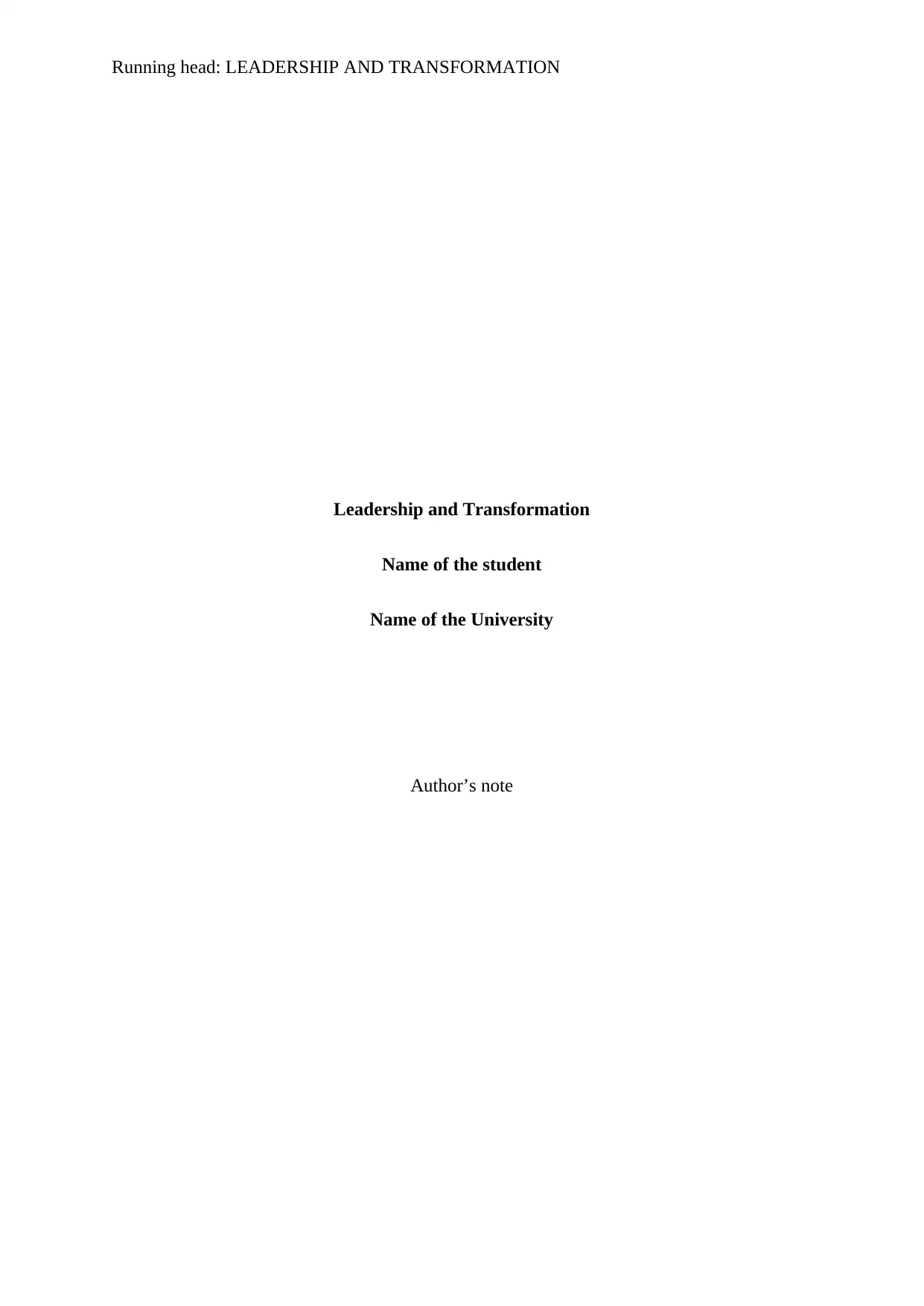
Running head: LEADERSHIP AND TRANSFORMATION
Leadership and Transformation
Name of the student
Name of the University
Author’s note
Leadership and Transformation
Name of the student
Name of the University
Author’s note
Secure Best Marks with AI Grader
Need help grading? Try our AI Grader for instant feedback on your assignments.
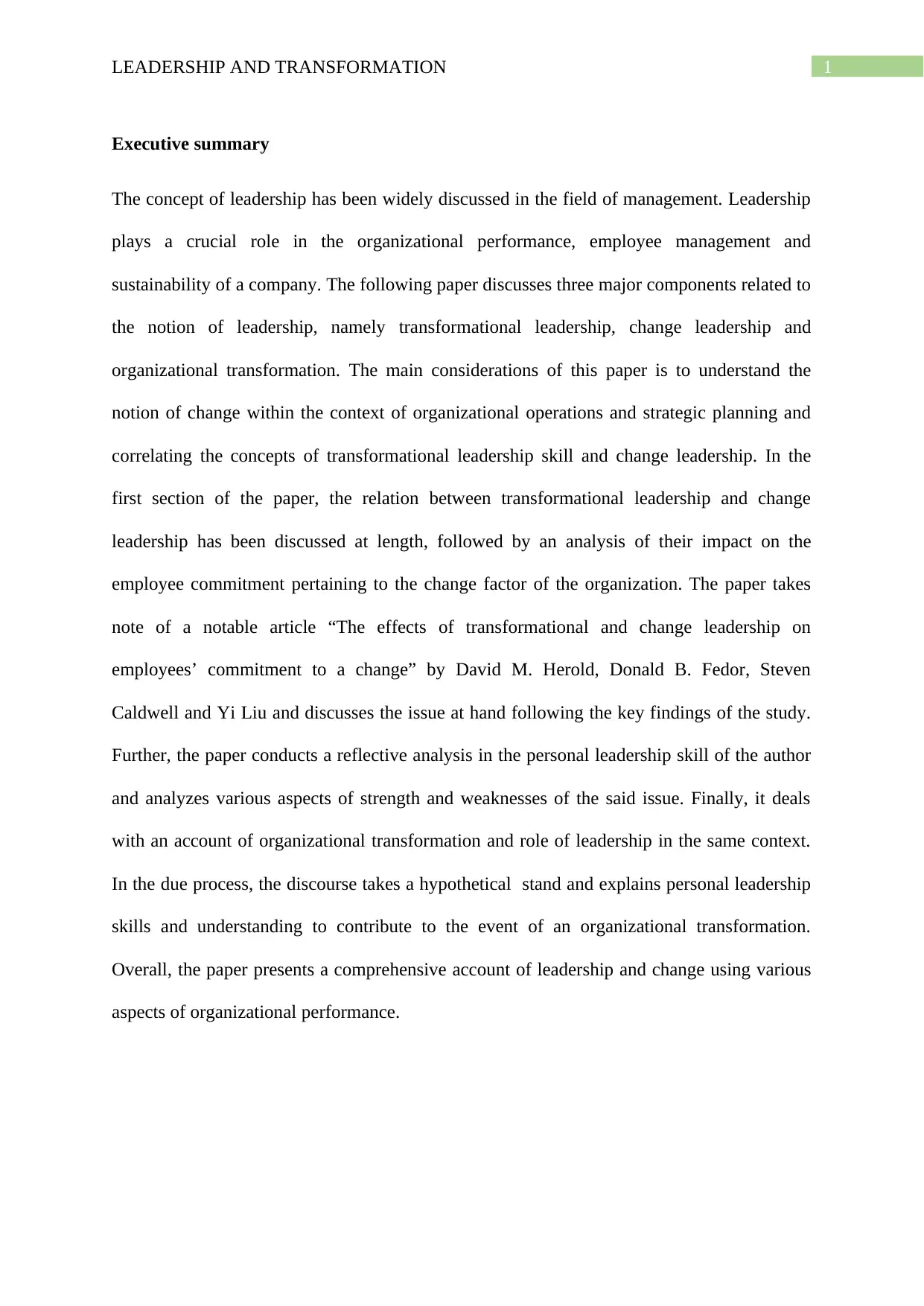
1LEADERSHIP AND TRANSFORMATION
Executive summary
The concept of leadership has been widely discussed in the field of management. Leadership
plays a crucial role in the organizational performance, employee management and
sustainability of a company. The following paper discusses three major components related to
the notion of leadership, namely transformational leadership, change leadership and
organizational transformation. The main considerations of this paper is to understand the
notion of change within the context of organizational operations and strategic planning and
correlating the concepts of transformational leadership skill and change leadership. In the
first section of the paper, the relation between transformational leadership and change
leadership has been discussed at length, followed by an analysis of their impact on the
employee commitment pertaining to the change factor of the organization. The paper takes
note of a notable article “The effects of transformational and change leadership on
employees’ commitment to a change” by David M. Herold, Donald B. Fedor, Steven
Caldwell and Yi Liu and discusses the issue at hand following the key findings of the study.
Further, the paper conducts a reflective analysis in the personal leadership skill of the author
and analyzes various aspects of strength and weaknesses of the said issue. Finally, it deals
with an account of organizational transformation and role of leadership in the same context.
In the due process, the discourse takes a hypothetical stand and explains personal leadership
skills and understanding to contribute to the event of an organizational transformation.
Overall, the paper presents a comprehensive account of leadership and change using various
aspects of organizational performance.
Executive summary
The concept of leadership has been widely discussed in the field of management. Leadership
plays a crucial role in the organizational performance, employee management and
sustainability of a company. The following paper discusses three major components related to
the notion of leadership, namely transformational leadership, change leadership and
organizational transformation. The main considerations of this paper is to understand the
notion of change within the context of organizational operations and strategic planning and
correlating the concepts of transformational leadership skill and change leadership. In the
first section of the paper, the relation between transformational leadership and change
leadership has been discussed at length, followed by an analysis of their impact on the
employee commitment pertaining to the change factor of the organization. The paper takes
note of a notable article “The effects of transformational and change leadership on
employees’ commitment to a change” by David M. Herold, Donald B. Fedor, Steven
Caldwell and Yi Liu and discusses the issue at hand following the key findings of the study.
Further, the paper conducts a reflective analysis in the personal leadership skill of the author
and analyzes various aspects of strength and weaknesses of the said issue. Finally, it deals
with an account of organizational transformation and role of leadership in the same context.
In the due process, the discourse takes a hypothetical stand and explains personal leadership
skills and understanding to contribute to the event of an organizational transformation.
Overall, the paper presents a comprehensive account of leadership and change using various
aspects of organizational performance.
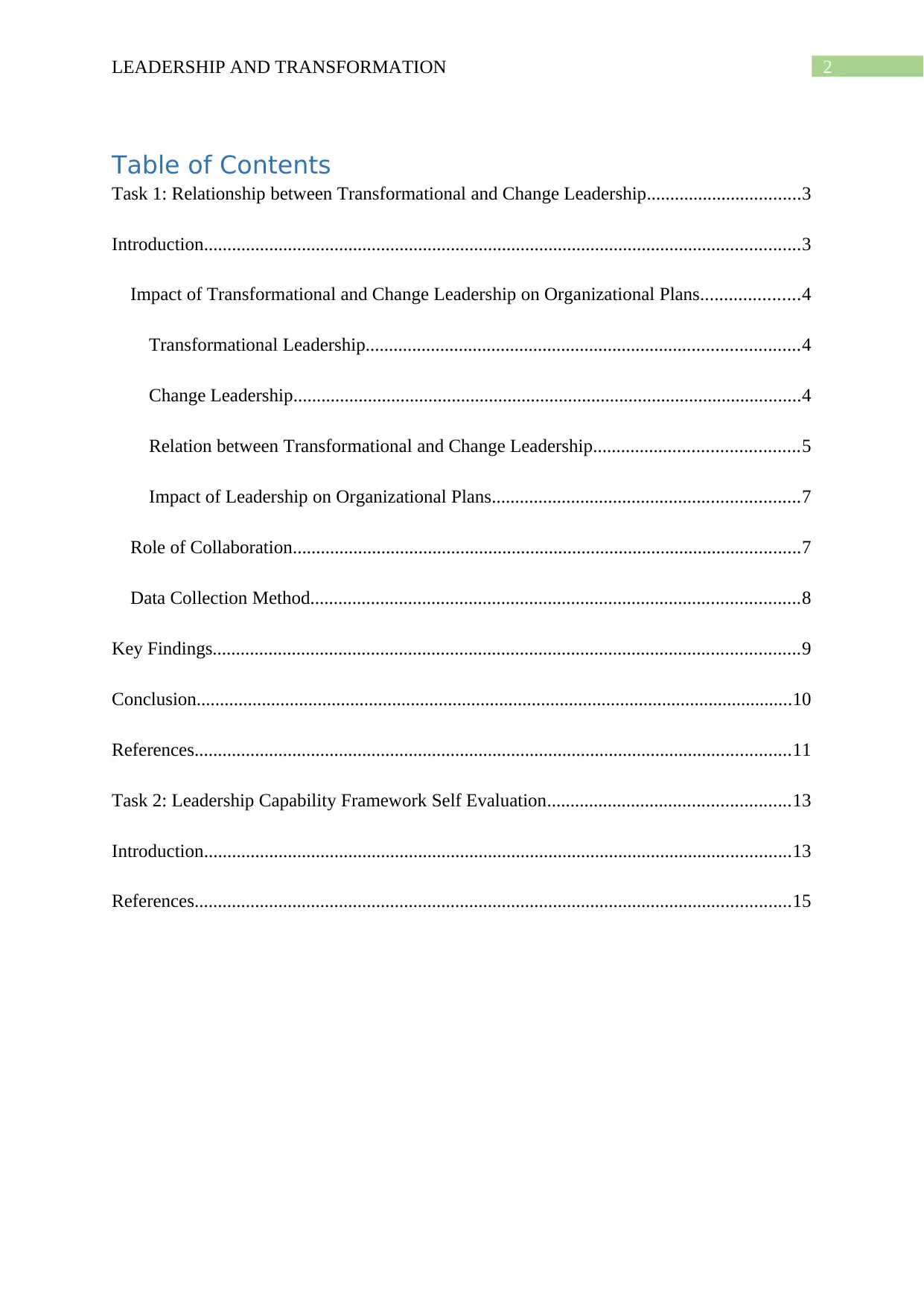
2LEADERSHIP AND TRANSFORMATION
Table of Contents
Task 1: Relationship between Transformational and Change Leadership.................................3
Introduction................................................................................................................................3
Impact of Transformational and Change Leadership on Organizational Plans.....................4
Transformational Leadership.............................................................................................4
Change Leadership.............................................................................................................4
Relation between Transformational and Change Leadership............................................5
Impact of Leadership on Organizational Plans..................................................................7
Role of Collaboration.............................................................................................................7
Data Collection Method.........................................................................................................8
Key Findings..............................................................................................................................9
Conclusion................................................................................................................................10
References................................................................................................................................11
Task 2: Leadership Capability Framework Self Evaluation....................................................13
Introduction..............................................................................................................................13
References................................................................................................................................15
Table of Contents
Task 1: Relationship between Transformational and Change Leadership.................................3
Introduction................................................................................................................................3
Impact of Transformational and Change Leadership on Organizational Plans.....................4
Transformational Leadership.............................................................................................4
Change Leadership.............................................................................................................4
Relation between Transformational and Change Leadership............................................5
Impact of Leadership on Organizational Plans..................................................................7
Role of Collaboration.............................................................................................................7
Data Collection Method.........................................................................................................8
Key Findings..............................................................................................................................9
Conclusion................................................................................................................................10
References................................................................................................................................11
Task 2: Leadership Capability Framework Self Evaluation....................................................13
Introduction..............................................................................................................................13
References................................................................................................................................15
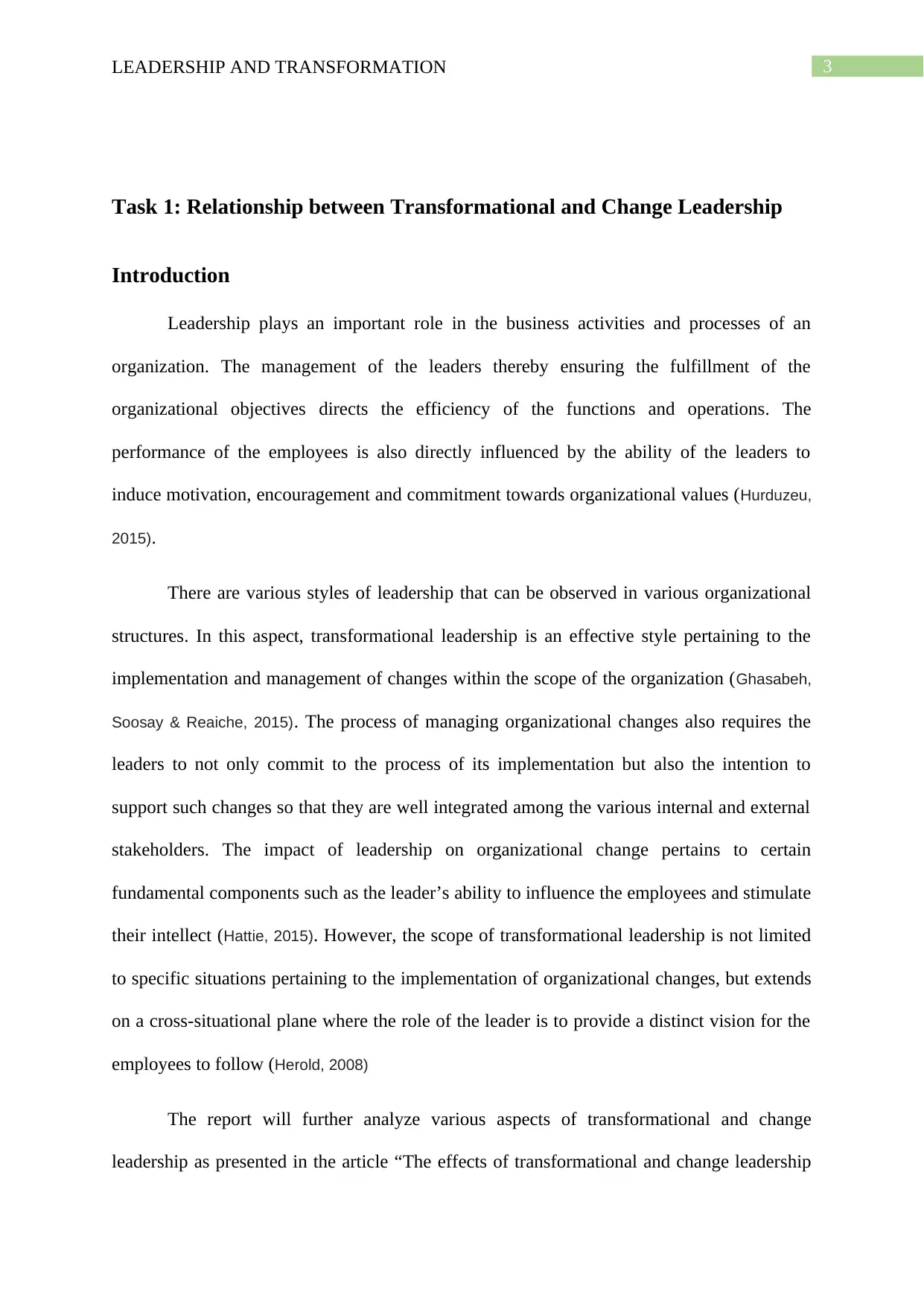
3LEADERSHIP AND TRANSFORMATION
Task 1: Relationship between Transformational and Change Leadership
Introduction
Leadership plays an important role in the business activities and processes of an
organization. The management of the leaders thereby ensuring the fulfillment of the
organizational objectives directs the efficiency of the functions and operations. The
performance of the employees is also directly influenced by the ability of the leaders to
induce motivation, encouragement and commitment towards organizational values (Hurduzeu,
2015).
There are various styles of leadership that can be observed in various organizational
structures. In this aspect, transformational leadership is an effective style pertaining to the
implementation and management of changes within the scope of the organization (Ghasabeh,
Soosay & Reaiche, 2015). The process of managing organizational changes also requires the
leaders to not only commit to the process of its implementation but also the intention to
support such changes so that they are well integrated among the various internal and external
stakeholders. The impact of leadership on organizational change pertains to certain
fundamental components such as the leader’s ability to influence the employees and stimulate
their intellect (Hattie, 2015). However, the scope of transformational leadership is not limited
to specific situations pertaining to the implementation of organizational changes, but extends
on a cross-situational plane where the role of the leader is to provide a distinct vision for the
employees to follow (Herold, 2008)
The report will further analyze various aspects of transformational and change
leadership as presented in the article “The effects of transformational and change leadership
Task 1: Relationship between Transformational and Change Leadership
Introduction
Leadership plays an important role in the business activities and processes of an
organization. The management of the leaders thereby ensuring the fulfillment of the
organizational objectives directs the efficiency of the functions and operations. The
performance of the employees is also directly influenced by the ability of the leaders to
induce motivation, encouragement and commitment towards organizational values (Hurduzeu,
2015).
There are various styles of leadership that can be observed in various organizational
structures. In this aspect, transformational leadership is an effective style pertaining to the
implementation and management of changes within the scope of the organization (Ghasabeh,
Soosay & Reaiche, 2015). The process of managing organizational changes also requires the
leaders to not only commit to the process of its implementation but also the intention to
support such changes so that they are well integrated among the various internal and external
stakeholders. The impact of leadership on organizational change pertains to certain
fundamental components such as the leader’s ability to influence the employees and stimulate
their intellect (Hattie, 2015). However, the scope of transformational leadership is not limited
to specific situations pertaining to the implementation of organizational changes, but extends
on a cross-situational plane where the role of the leader is to provide a distinct vision for the
employees to follow (Herold, 2008)
The report will further analyze various aspects of transformational and change
leadership as presented in the article “The effects of transformational and change leadership
Secure Best Marks with AI Grader
Need help grading? Try our AI Grader for instant feedback on your assignments.

4LEADERSHIP AND TRANSFORMATION
on employees’ commitment to a change” by David M. Herold, Donald B. Fedor, Steven
Caldwell and Yi Liu. The impact of various styles of leadership on the attitude and
performance of the employees will also be discussed pertaining to the organizational
objectives and how they are met through a process of change implementation.
Impact of Transformational and Change Leadership on Organizational Plans
Transformational Leadership
Transformational leadership can be described as the ability observed among leaders to
develop and integrate values and a vision that can encourage the followers to adapt and
accommodate changes (Bass & Riggio, 2006). The development of an organizational vision
also encompasses the need for its communication along with the creation of empowering
opportunities. Among other factors observed in transformational style of leadership,
admiration, trust and credibility are of primary importance. Transformational leadership is
conceptualized on a dual level, namely individual and work unit. Individual level comprises
of discretionary stimuli that involves the leader’s attention on the individual employees
differentially. Group or work unit level involves ambient stimuli that is experienced and
shared by groups of employees. (Herold et al., 2008)
Change Leadership
Change leadership involves the process by which organizational changes are
strategized and implemented by the leaders (Hughes & Ford, 2016). This style of leadership can
be described as the leader’s ability to enthuse and motivate the followers or employees
through drive, vision and personal advocacy and provide an adequate access of resources so
as to build a solid foundation for the implementation of changes within the scope of the
organization (Holten & Brenner, 2015). Change leadership follows a participative style
involving the opinions and ideation of the employees in order to strategies the policies of
on employees’ commitment to a change” by David M. Herold, Donald B. Fedor, Steven
Caldwell and Yi Liu. The impact of various styles of leadership on the attitude and
performance of the employees will also be discussed pertaining to the organizational
objectives and how they are met through a process of change implementation.
Impact of Transformational and Change Leadership on Organizational Plans
Transformational Leadership
Transformational leadership can be described as the ability observed among leaders to
develop and integrate values and a vision that can encourage the followers to adapt and
accommodate changes (Bass & Riggio, 2006). The development of an organizational vision
also encompasses the need for its communication along with the creation of empowering
opportunities. Among other factors observed in transformational style of leadership,
admiration, trust and credibility are of primary importance. Transformational leadership is
conceptualized on a dual level, namely individual and work unit. Individual level comprises
of discretionary stimuli that involves the leader’s attention on the individual employees
differentially. Group or work unit level involves ambient stimuli that is experienced and
shared by groups of employees. (Herold et al., 2008)
Change Leadership
Change leadership involves the process by which organizational changes are
strategized and implemented by the leaders (Hughes & Ford, 2016). This style of leadership can
be described as the leader’s ability to enthuse and motivate the followers or employees
through drive, vision and personal advocacy and provide an adequate access of resources so
as to build a solid foundation for the implementation of changes within the scope of the
organization (Holten & Brenner, 2015). Change leadership follows a participative style
involving the opinions and ideation of the employees in order to strategies the policies of
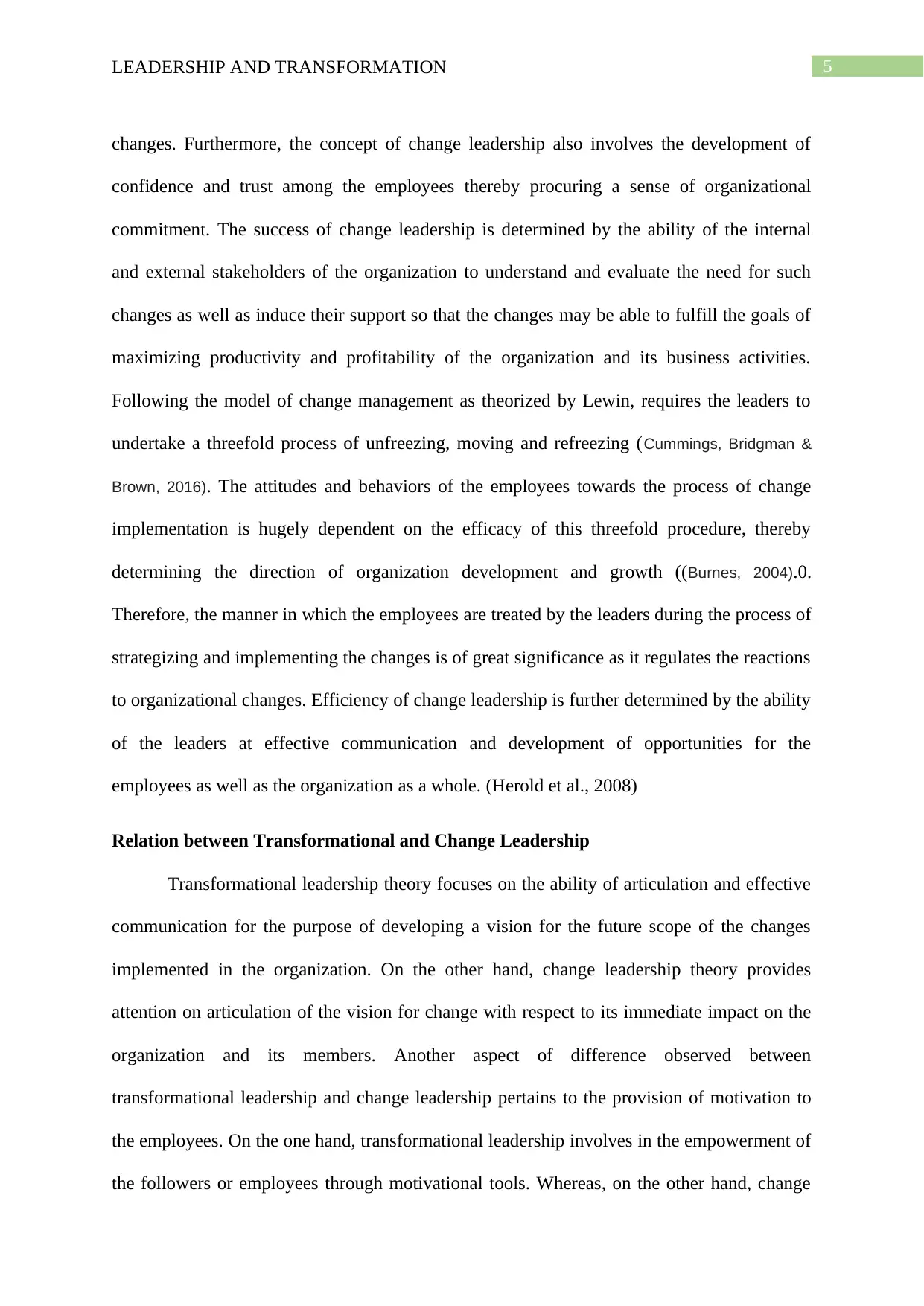
5LEADERSHIP AND TRANSFORMATION
changes. Furthermore, the concept of change leadership also involves the development of
confidence and trust among the employees thereby procuring a sense of organizational
commitment. The success of change leadership is determined by the ability of the internal
and external stakeholders of the organization to understand and evaluate the need for such
changes as well as induce their support so that the changes may be able to fulfill the goals of
maximizing productivity and profitability of the organization and its business activities.
Following the model of change management as theorized by Lewin, requires the leaders to
undertake a threefold process of unfreezing, moving and refreezing (Cummings, Bridgman &
Brown, 2016). The attitudes and behaviors of the employees towards the process of change
implementation is hugely dependent on the efficacy of this threefold procedure, thereby
determining the direction of organization development and growth ((Burnes, 2004).0.
Therefore, the manner in which the employees are treated by the leaders during the process of
strategizing and implementing the changes is of great significance as it regulates the reactions
to organizational changes. Efficiency of change leadership is further determined by the ability
of the leaders at effective communication and development of opportunities for the
employees as well as the organization as a whole. (Herold et al., 2008)
Relation between Transformational and Change Leadership
Transformational leadership theory focuses on the ability of articulation and effective
communication for the purpose of developing a vision for the future scope of the changes
implemented in the organization. On the other hand, change leadership theory provides
attention on articulation of the vision for change with respect to its immediate impact on the
organization and its members. Another aspect of difference observed between
transformational leadership and change leadership pertains to the provision of motivation to
the employees. On the one hand, transformational leadership involves in the empowerment of
the followers or employees through motivational tools. Whereas, on the other hand, change
changes. Furthermore, the concept of change leadership also involves the development of
confidence and trust among the employees thereby procuring a sense of organizational
commitment. The success of change leadership is determined by the ability of the internal
and external stakeholders of the organization to understand and evaluate the need for such
changes as well as induce their support so that the changes may be able to fulfill the goals of
maximizing productivity and profitability of the organization and its business activities.
Following the model of change management as theorized by Lewin, requires the leaders to
undertake a threefold process of unfreezing, moving and refreezing (Cummings, Bridgman &
Brown, 2016). The attitudes and behaviors of the employees towards the process of change
implementation is hugely dependent on the efficacy of this threefold procedure, thereby
determining the direction of organization development and growth ((Burnes, 2004).0.
Therefore, the manner in which the employees are treated by the leaders during the process of
strategizing and implementing the changes is of great significance as it regulates the reactions
to organizational changes. Efficiency of change leadership is further determined by the ability
of the leaders at effective communication and development of opportunities for the
employees as well as the organization as a whole. (Herold et al., 2008)
Relation between Transformational and Change Leadership
Transformational leadership theory focuses on the ability of articulation and effective
communication for the purpose of developing a vision for the future scope of the changes
implemented in the organization. On the other hand, change leadership theory provides
attention on articulation of the vision for change with respect to its immediate impact on the
organization and its members. Another aspect of difference observed between
transformational leadership and change leadership pertains to the provision of motivation to
the employees. On the one hand, transformational leadership involves in the empowerment of
the followers or employees through motivational tools. Whereas, on the other hand, change
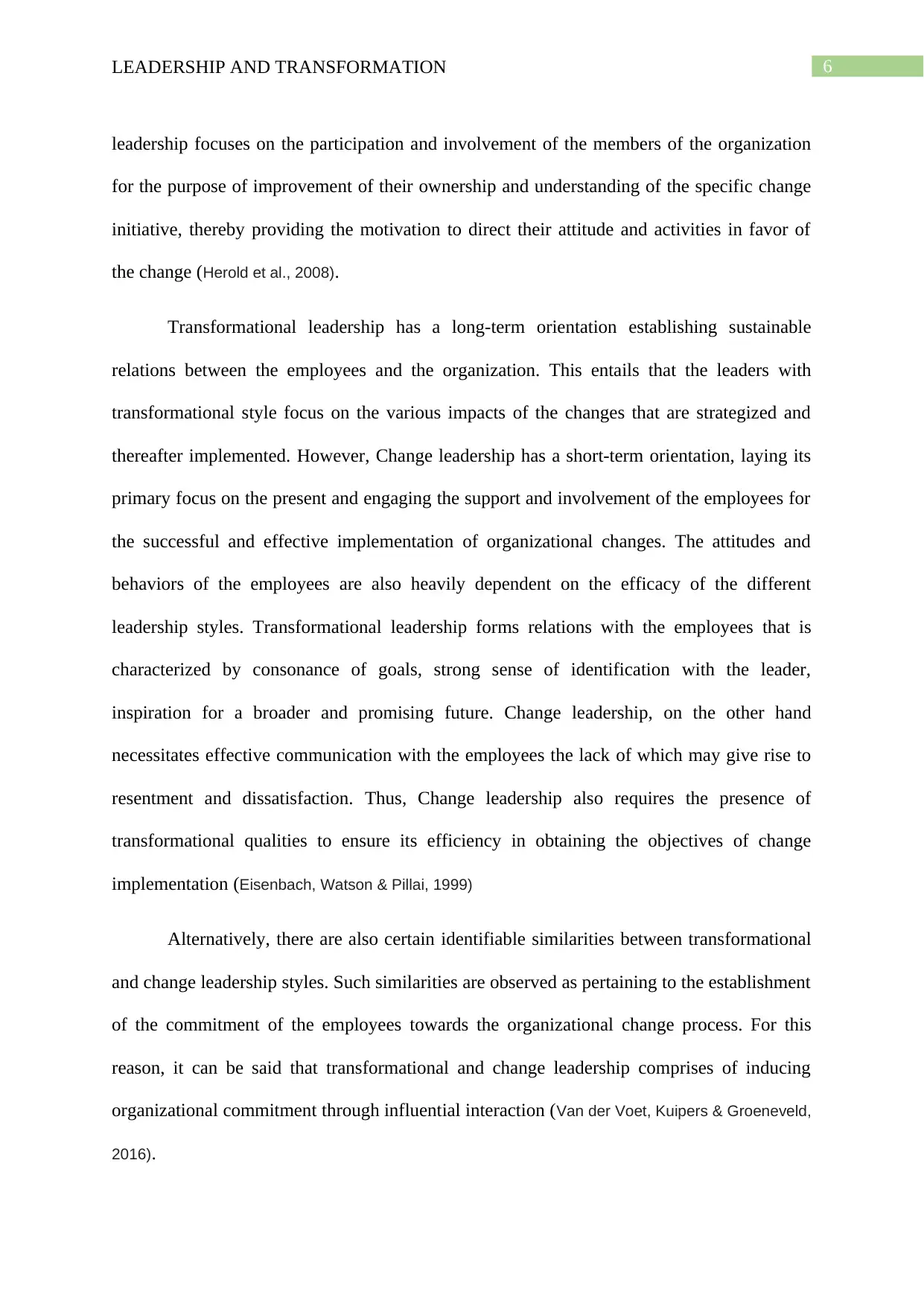
6LEADERSHIP AND TRANSFORMATION
leadership focuses on the participation and involvement of the members of the organization
for the purpose of improvement of their ownership and understanding of the specific change
initiative, thereby providing the motivation to direct their attitude and activities in favor of
the change (Herold et al., 2008).
Transformational leadership has a long-term orientation establishing sustainable
relations between the employees and the organization. This entails that the leaders with
transformational style focus on the various impacts of the changes that are strategized and
thereafter implemented. However, Change leadership has a short-term orientation, laying its
primary focus on the present and engaging the support and involvement of the employees for
the successful and effective implementation of organizational changes. The attitudes and
behaviors of the employees are also heavily dependent on the efficacy of the different
leadership styles. Transformational leadership forms relations with the employees that is
characterized by consonance of goals, strong sense of identification with the leader,
inspiration for a broader and promising future. Change leadership, on the other hand
necessitates effective communication with the employees the lack of which may give rise to
resentment and dissatisfaction. Thus, Change leadership also requires the presence of
transformational qualities to ensure its efficiency in obtaining the objectives of change
implementation (Eisenbach, Watson & Pillai, 1999)
Alternatively, there are also certain identifiable similarities between transformational
and change leadership styles. Such similarities are observed as pertaining to the establishment
of the commitment of the employees towards the organizational change process. For this
reason, it can be said that transformational and change leadership comprises of inducing
organizational commitment through influential interaction (Van der Voet, Kuipers & Groeneveld,
2016).
leadership focuses on the participation and involvement of the members of the organization
for the purpose of improvement of their ownership and understanding of the specific change
initiative, thereby providing the motivation to direct their attitude and activities in favor of
the change (Herold et al., 2008).
Transformational leadership has a long-term orientation establishing sustainable
relations between the employees and the organization. This entails that the leaders with
transformational style focus on the various impacts of the changes that are strategized and
thereafter implemented. However, Change leadership has a short-term orientation, laying its
primary focus on the present and engaging the support and involvement of the employees for
the successful and effective implementation of organizational changes. The attitudes and
behaviors of the employees are also heavily dependent on the efficacy of the different
leadership styles. Transformational leadership forms relations with the employees that is
characterized by consonance of goals, strong sense of identification with the leader,
inspiration for a broader and promising future. Change leadership, on the other hand
necessitates effective communication with the employees the lack of which may give rise to
resentment and dissatisfaction. Thus, Change leadership also requires the presence of
transformational qualities to ensure its efficiency in obtaining the objectives of change
implementation (Eisenbach, Watson & Pillai, 1999)
Alternatively, there are also certain identifiable similarities between transformational
and change leadership styles. Such similarities are observed as pertaining to the establishment
of the commitment of the employees towards the organizational change process. For this
reason, it can be said that transformational and change leadership comprises of inducing
organizational commitment through influential interaction (Van der Voet, Kuipers & Groeneveld,
2016).
Paraphrase This Document
Need a fresh take? Get an instant paraphrase of this document with our AI Paraphraser
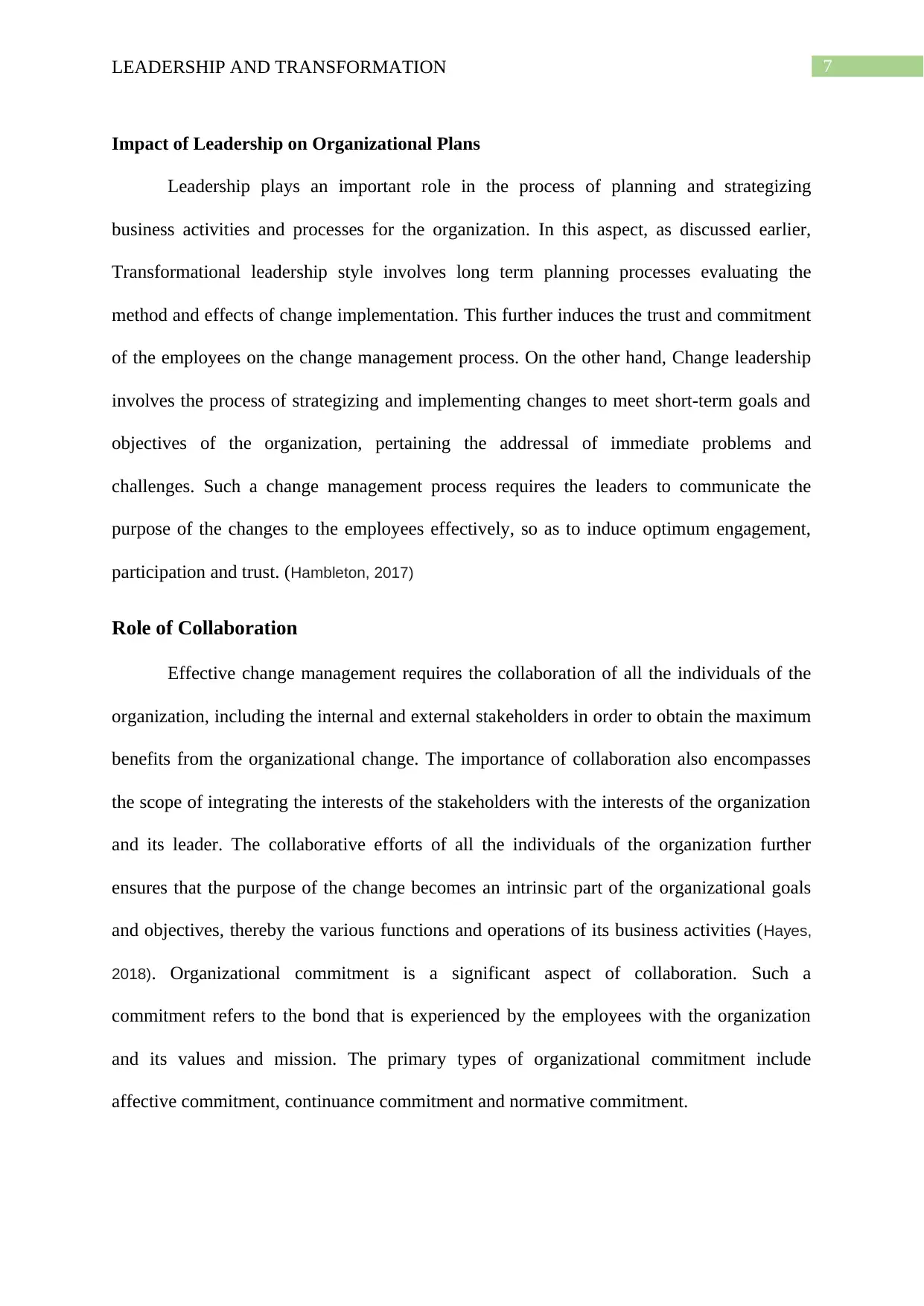
7LEADERSHIP AND TRANSFORMATION
Impact of Leadership on Organizational Plans
Leadership plays an important role in the process of planning and strategizing
business activities and processes for the organization. In this aspect, as discussed earlier,
Transformational leadership style involves long term planning processes evaluating the
method and effects of change implementation. This further induces the trust and commitment
of the employees on the change management process. On the other hand, Change leadership
involves the process of strategizing and implementing changes to meet short-term goals and
objectives of the organization, pertaining the addressal of immediate problems and
challenges. Such a change management process requires the leaders to communicate the
purpose of the changes to the employees effectively, so as to induce optimum engagement,
participation and trust. (Hambleton, 2017)
Role of Collaboration
Effective change management requires the collaboration of all the individuals of the
organization, including the internal and external stakeholders in order to obtain the maximum
benefits from the organizational change. The importance of collaboration also encompasses
the scope of integrating the interests of the stakeholders with the interests of the organization
and its leader. The collaborative efforts of all the individuals of the organization further
ensures that the purpose of the change becomes an intrinsic part of the organizational goals
and objectives, thereby the various functions and operations of its business activities (Hayes,
2018). Organizational commitment is a significant aspect of collaboration. Such a
commitment refers to the bond that is experienced by the employees with the organization
and its values and mission. The primary types of organizational commitment include
affective commitment, continuance commitment and normative commitment.
Impact of Leadership on Organizational Plans
Leadership plays an important role in the process of planning and strategizing
business activities and processes for the organization. In this aspect, as discussed earlier,
Transformational leadership style involves long term planning processes evaluating the
method and effects of change implementation. This further induces the trust and commitment
of the employees on the change management process. On the other hand, Change leadership
involves the process of strategizing and implementing changes to meet short-term goals and
objectives of the organization, pertaining the addressal of immediate problems and
challenges. Such a change management process requires the leaders to communicate the
purpose of the changes to the employees effectively, so as to induce optimum engagement,
participation and trust. (Hambleton, 2017)
Role of Collaboration
Effective change management requires the collaboration of all the individuals of the
organization, including the internal and external stakeholders in order to obtain the maximum
benefits from the organizational change. The importance of collaboration also encompasses
the scope of integrating the interests of the stakeholders with the interests of the organization
and its leader. The collaborative efforts of all the individuals of the organization further
ensures that the purpose of the change becomes an intrinsic part of the organizational goals
and objectives, thereby the various functions and operations of its business activities (Hayes,
2018). Organizational commitment is a significant aspect of collaboration. Such a
commitment refers to the bond that is experienced by the employees with the organization
and its values and mission. The primary types of organizational commitment include
affective commitment, continuance commitment and normative commitment.
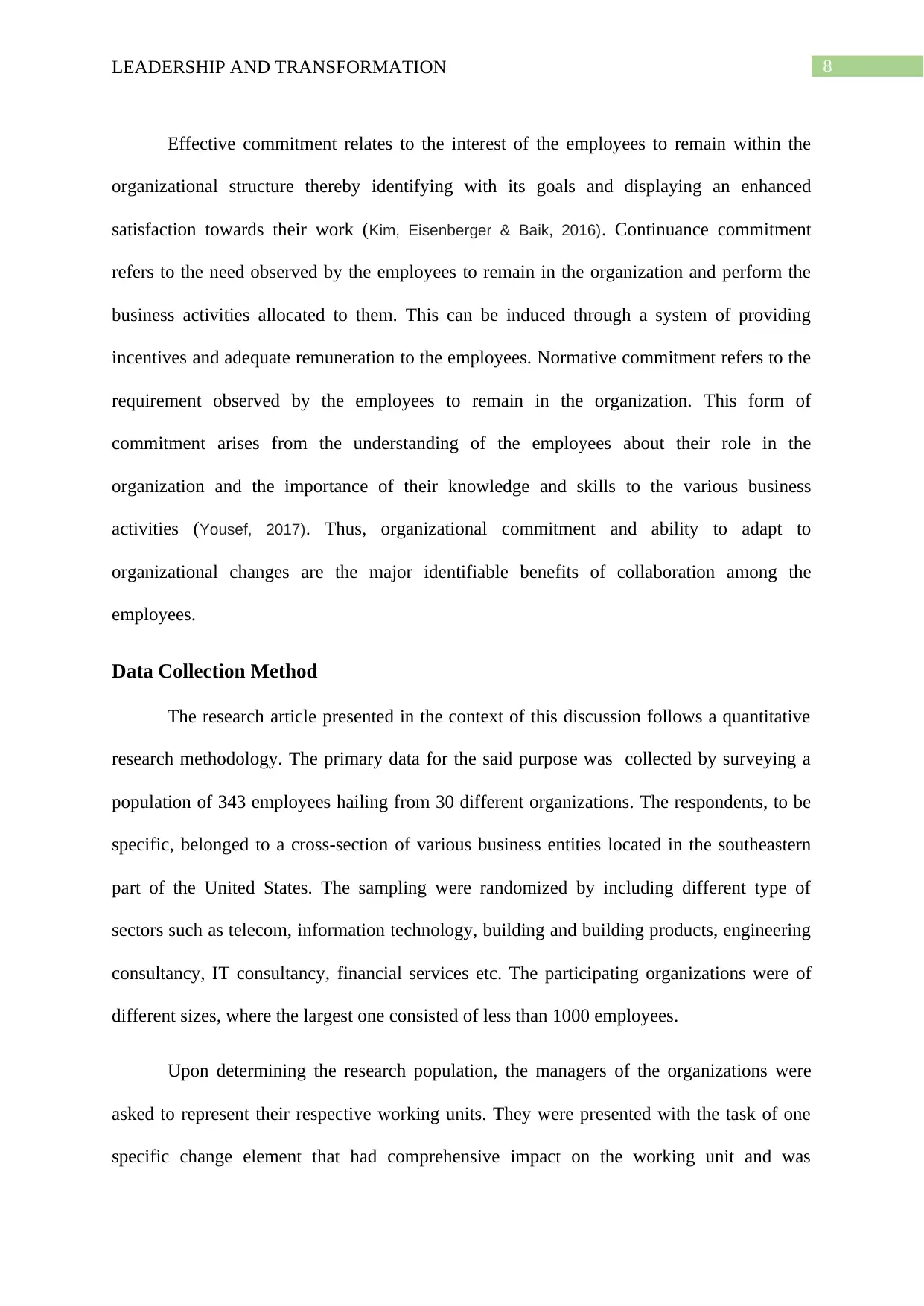
8LEADERSHIP AND TRANSFORMATION
Effective commitment relates to the interest of the employees to remain within the
organizational structure thereby identifying with its goals and displaying an enhanced
satisfaction towards their work (Kim, Eisenberger & Baik, 2016). Continuance commitment
refers to the need observed by the employees to remain in the organization and perform the
business activities allocated to them. This can be induced through a system of providing
incentives and adequate remuneration to the employees. Normative commitment refers to the
requirement observed by the employees to remain in the organization. This form of
commitment arises from the understanding of the employees about their role in the
organization and the importance of their knowledge and skills to the various business
activities (Yousef, 2017). Thus, organizational commitment and ability to adapt to
organizational changes are the major identifiable benefits of collaboration among the
employees.
Data Collection Method
The research article presented in the context of this discussion follows a quantitative
research methodology. The primary data for the said purpose was collected by surveying a
population of 343 employees hailing from 30 different organizations. The respondents, to be
specific, belonged to a cross-section of various business entities located in the southeastern
part of the United States. The sampling were randomized by including different type of
sectors such as telecom, information technology, building and building products, engineering
consultancy, IT consultancy, financial services etc. The participating organizations were of
different sizes, where the largest one consisted of less than 1000 employees.
Upon determining the research population, the managers of the organizations were
asked to represent their respective working units. They were presented with the task of one
specific change element that had comprehensive impact on the working unit and was
Effective commitment relates to the interest of the employees to remain within the
organizational structure thereby identifying with its goals and displaying an enhanced
satisfaction towards their work (Kim, Eisenberger & Baik, 2016). Continuance commitment
refers to the need observed by the employees to remain in the organization and perform the
business activities allocated to them. This can be induced through a system of providing
incentives and adequate remuneration to the employees. Normative commitment refers to the
requirement observed by the employees to remain in the organization. This form of
commitment arises from the understanding of the employees about their role in the
organization and the importance of their knowledge and skills to the various business
activities (Yousef, 2017). Thus, organizational commitment and ability to adapt to
organizational changes are the major identifiable benefits of collaboration among the
employees.
Data Collection Method
The research article presented in the context of this discussion follows a quantitative
research methodology. The primary data for the said purpose was collected by surveying a
population of 343 employees hailing from 30 different organizations. The respondents, to be
specific, belonged to a cross-section of various business entities located in the southeastern
part of the United States. The sampling were randomized by including different type of
sectors such as telecom, information technology, building and building products, engineering
consultancy, IT consultancy, financial services etc. The participating organizations were of
different sizes, where the largest one consisted of less than 1000 employees.
Upon determining the research population, the managers of the organizations were
asked to represent their respective working units. They were presented with the task of one
specific change element that had comprehensive impact on the working unit and was
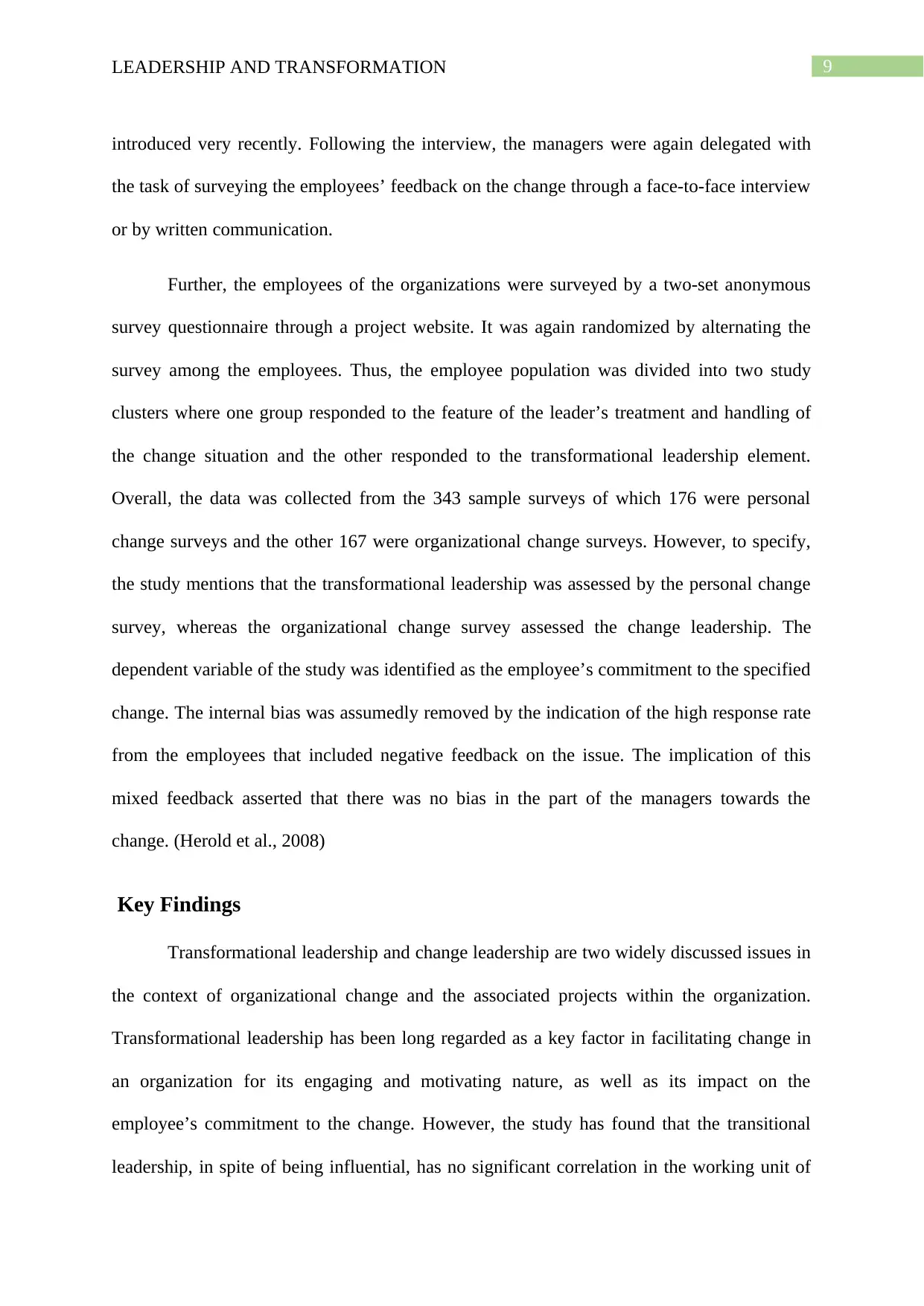
9LEADERSHIP AND TRANSFORMATION
introduced very recently. Following the interview, the managers were again delegated with
the task of surveying the employees’ feedback on the change through a face-to-face interview
or by written communication.
Further, the employees of the organizations were surveyed by a two-set anonymous
survey questionnaire through a project website. It was again randomized by alternating the
survey among the employees. Thus, the employee population was divided into two study
clusters where one group responded to the feature of the leader’s treatment and handling of
the change situation and the other responded to the transformational leadership element.
Overall, the data was collected from the 343 sample surveys of which 176 were personal
change surveys and the other 167 were organizational change surveys. However, to specify,
the study mentions that the transformational leadership was assessed by the personal change
survey, whereas the organizational change survey assessed the change leadership. The
dependent variable of the study was identified as the employee’s commitment to the specified
change. The internal bias was assumedly removed by the indication of the high response rate
from the employees that included negative feedback on the issue. The implication of this
mixed feedback asserted that there was no bias in the part of the managers towards the
change. (Herold et al., 2008)
Key Findings
Transformational leadership and change leadership are two widely discussed issues in
the context of organizational change and the associated projects within the organization.
Transformational leadership has been long regarded as a key factor in facilitating change in
an organization for its engaging and motivating nature, as well as its impact on the
employee’s commitment to the change. However, the study has found that the transitional
leadership, in spite of being influential, has no significant correlation in the working unit of
introduced very recently. Following the interview, the managers were again delegated with
the task of surveying the employees’ feedback on the change through a face-to-face interview
or by written communication.
Further, the employees of the organizations were surveyed by a two-set anonymous
survey questionnaire through a project website. It was again randomized by alternating the
survey among the employees. Thus, the employee population was divided into two study
clusters where one group responded to the feature of the leader’s treatment and handling of
the change situation and the other responded to the transformational leadership element.
Overall, the data was collected from the 343 sample surveys of which 176 were personal
change surveys and the other 167 were organizational change surveys. However, to specify,
the study mentions that the transformational leadership was assessed by the personal change
survey, whereas the organizational change survey assessed the change leadership. The
dependent variable of the study was identified as the employee’s commitment to the specified
change. The internal bias was assumedly removed by the indication of the high response rate
from the employees that included negative feedback on the issue. The implication of this
mixed feedback asserted that there was no bias in the part of the managers towards the
change. (Herold et al., 2008)
Key Findings
Transformational leadership and change leadership are two widely discussed issues in
the context of organizational change and the associated projects within the organization.
Transformational leadership has been long regarded as a key factor in facilitating change in
an organization for its engaging and motivating nature, as well as its impact on the
employee’s commitment to the change. However, the study has found that the transitional
leadership, in spite of being influential, has no significant correlation in the working unit of
Secure Best Marks with AI Grader
Need help grading? Try our AI Grader for instant feedback on your assignments.
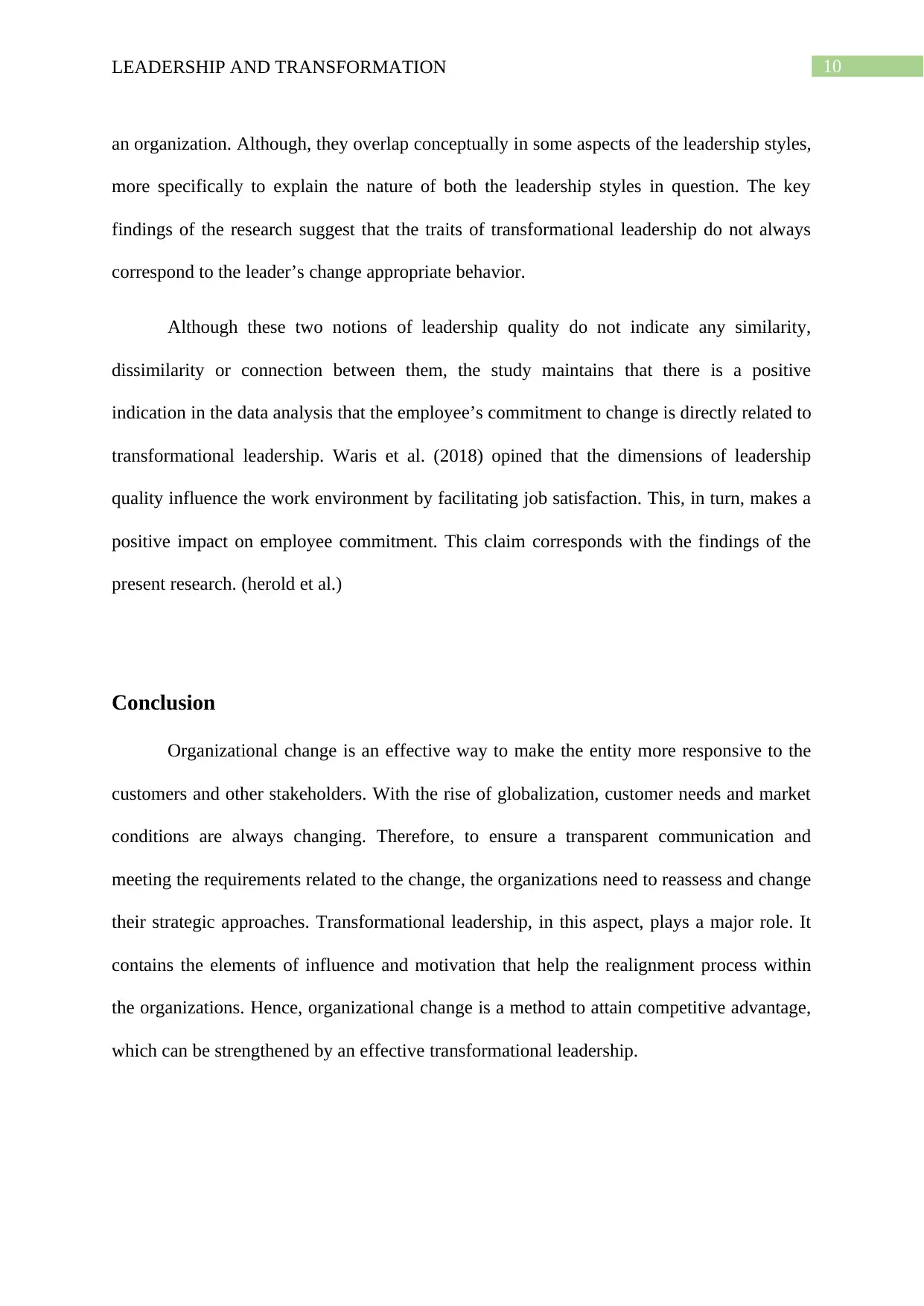
10LEADERSHIP AND TRANSFORMATION
an organization. Although, they overlap conceptually in some aspects of the leadership styles,
more specifically to explain the nature of both the leadership styles in question. The key
findings of the research suggest that the traits of transformational leadership do not always
correspond to the leader’s change appropriate behavior.
Although these two notions of leadership quality do not indicate any similarity,
dissimilarity or connection between them, the study maintains that there is a positive
indication in the data analysis that the employee’s commitment to change is directly related to
transformational leadership. Waris et al. (2018) opined that the dimensions of leadership
quality influence the work environment by facilitating job satisfaction. This, in turn, makes a
positive impact on employee commitment. This claim corresponds with the findings of the
present research. (herold et al.)
Conclusion
Organizational change is an effective way to make the entity more responsive to the
customers and other stakeholders. With the rise of globalization, customer needs and market
conditions are always changing. Therefore, to ensure a transparent communication and
meeting the requirements related to the change, the organizations need to reassess and change
their strategic approaches. Transformational leadership, in this aspect, plays a major role. It
contains the elements of influence and motivation that help the realignment process within
the organizations. Hence, organizational change is a method to attain competitive advantage,
which can be strengthened by an effective transformational leadership.
an organization. Although, they overlap conceptually in some aspects of the leadership styles,
more specifically to explain the nature of both the leadership styles in question. The key
findings of the research suggest that the traits of transformational leadership do not always
correspond to the leader’s change appropriate behavior.
Although these two notions of leadership quality do not indicate any similarity,
dissimilarity or connection between them, the study maintains that there is a positive
indication in the data analysis that the employee’s commitment to change is directly related to
transformational leadership. Waris et al. (2018) opined that the dimensions of leadership
quality influence the work environment by facilitating job satisfaction. This, in turn, makes a
positive impact on employee commitment. This claim corresponds with the findings of the
present research. (herold et al.)
Conclusion
Organizational change is an effective way to make the entity more responsive to the
customers and other stakeholders. With the rise of globalization, customer needs and market
conditions are always changing. Therefore, to ensure a transparent communication and
meeting the requirements related to the change, the organizations need to reassess and change
their strategic approaches. Transformational leadership, in this aspect, plays a major role. It
contains the elements of influence and motivation that help the realignment process within
the organizations. Hence, organizational change is a method to attain competitive advantage,
which can be strengthened by an effective transformational leadership.
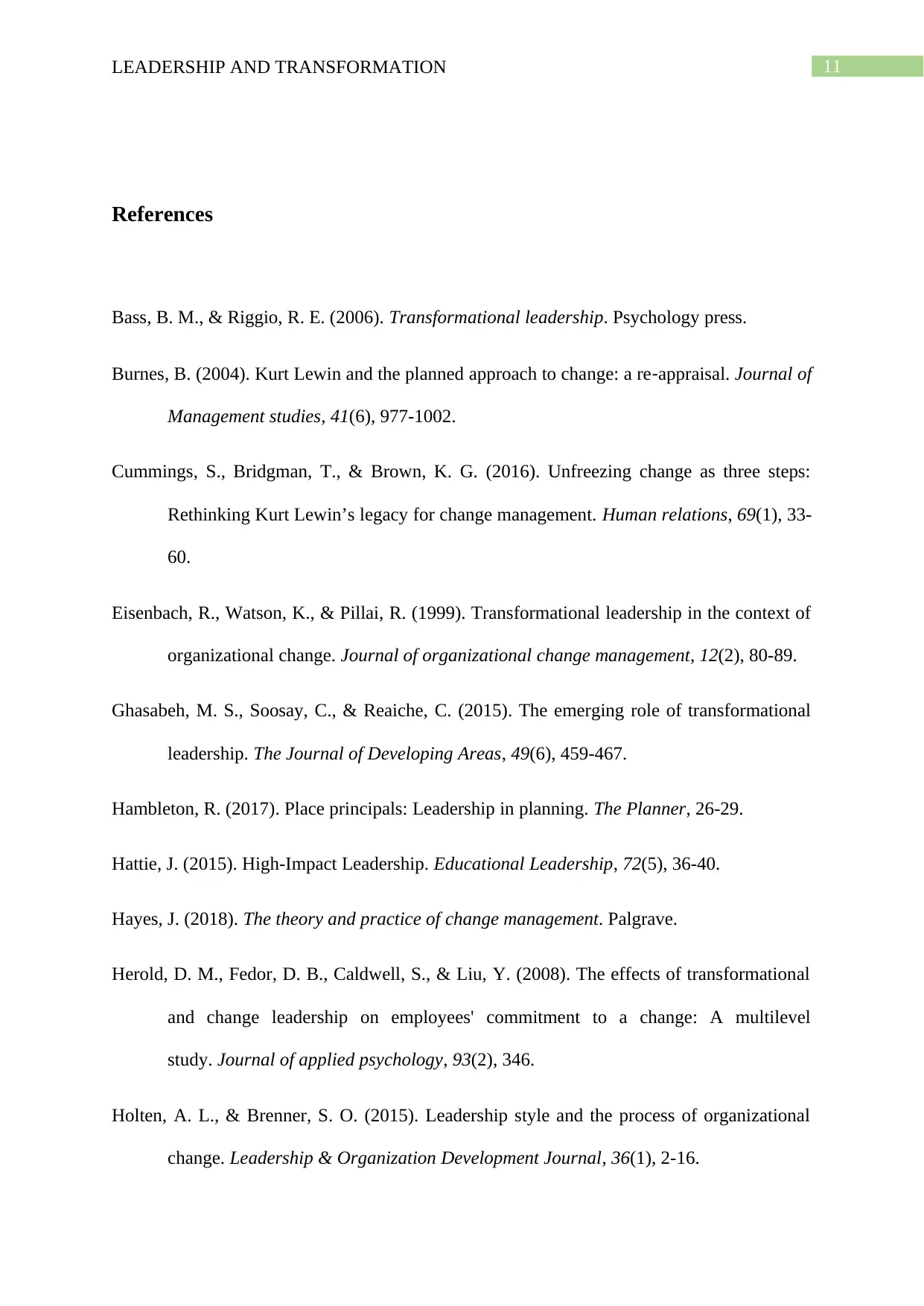
11LEADERSHIP AND TRANSFORMATION
References
Bass, B. M., & Riggio, R. E. (2006). Transformational leadership. Psychology press.
Burnes, B. (2004). Kurt Lewin and the planned approach to change: a re‐appraisal. Journal of
Management studies, 41(6), 977-1002.
Cummings, S., Bridgman, T., & Brown, K. G. (2016). Unfreezing change as three steps:
Rethinking Kurt Lewin’s legacy for change management. Human relations, 69(1), 33-
60.
Eisenbach, R., Watson, K., & Pillai, R. (1999). Transformational leadership in the context of
organizational change. Journal of organizational change management, 12(2), 80-89.
Ghasabeh, M. S., Soosay, C., & Reaiche, C. (2015). The emerging role of transformational
leadership. The Journal of Developing Areas, 49(6), 459-467.
Hambleton, R. (2017). Place principals: Leadership in planning. The Planner, 26-29.
Hattie, J. (2015). High-Impact Leadership. Educational Leadership, 72(5), 36-40.
Hayes, J. (2018). The theory and practice of change management. Palgrave.
Herold, D. M., Fedor, D. B., Caldwell, S., & Liu, Y. (2008). The effects of transformational
and change leadership on employees' commitment to a change: A multilevel
study. Journal of applied psychology, 93(2), 346.
Holten, A. L., & Brenner, S. O. (2015). Leadership style and the process of organizational
change. Leadership & Organization Development Journal, 36(1), 2-16.
References
Bass, B. M., & Riggio, R. E. (2006). Transformational leadership. Psychology press.
Burnes, B. (2004). Kurt Lewin and the planned approach to change: a re‐appraisal. Journal of
Management studies, 41(6), 977-1002.
Cummings, S., Bridgman, T., & Brown, K. G. (2016). Unfreezing change as three steps:
Rethinking Kurt Lewin’s legacy for change management. Human relations, 69(1), 33-
60.
Eisenbach, R., Watson, K., & Pillai, R. (1999). Transformational leadership in the context of
organizational change. Journal of organizational change management, 12(2), 80-89.
Ghasabeh, M. S., Soosay, C., & Reaiche, C. (2015). The emerging role of transformational
leadership. The Journal of Developing Areas, 49(6), 459-467.
Hambleton, R. (2017). Place principals: Leadership in planning. The Planner, 26-29.
Hattie, J. (2015). High-Impact Leadership. Educational Leadership, 72(5), 36-40.
Hayes, J. (2018). The theory and practice of change management. Palgrave.
Herold, D. M., Fedor, D. B., Caldwell, S., & Liu, Y. (2008). The effects of transformational
and change leadership on employees' commitment to a change: A multilevel
study. Journal of applied psychology, 93(2), 346.
Holten, A. L., & Brenner, S. O. (2015). Leadership style and the process of organizational
change. Leadership & Organization Development Journal, 36(1), 2-16.
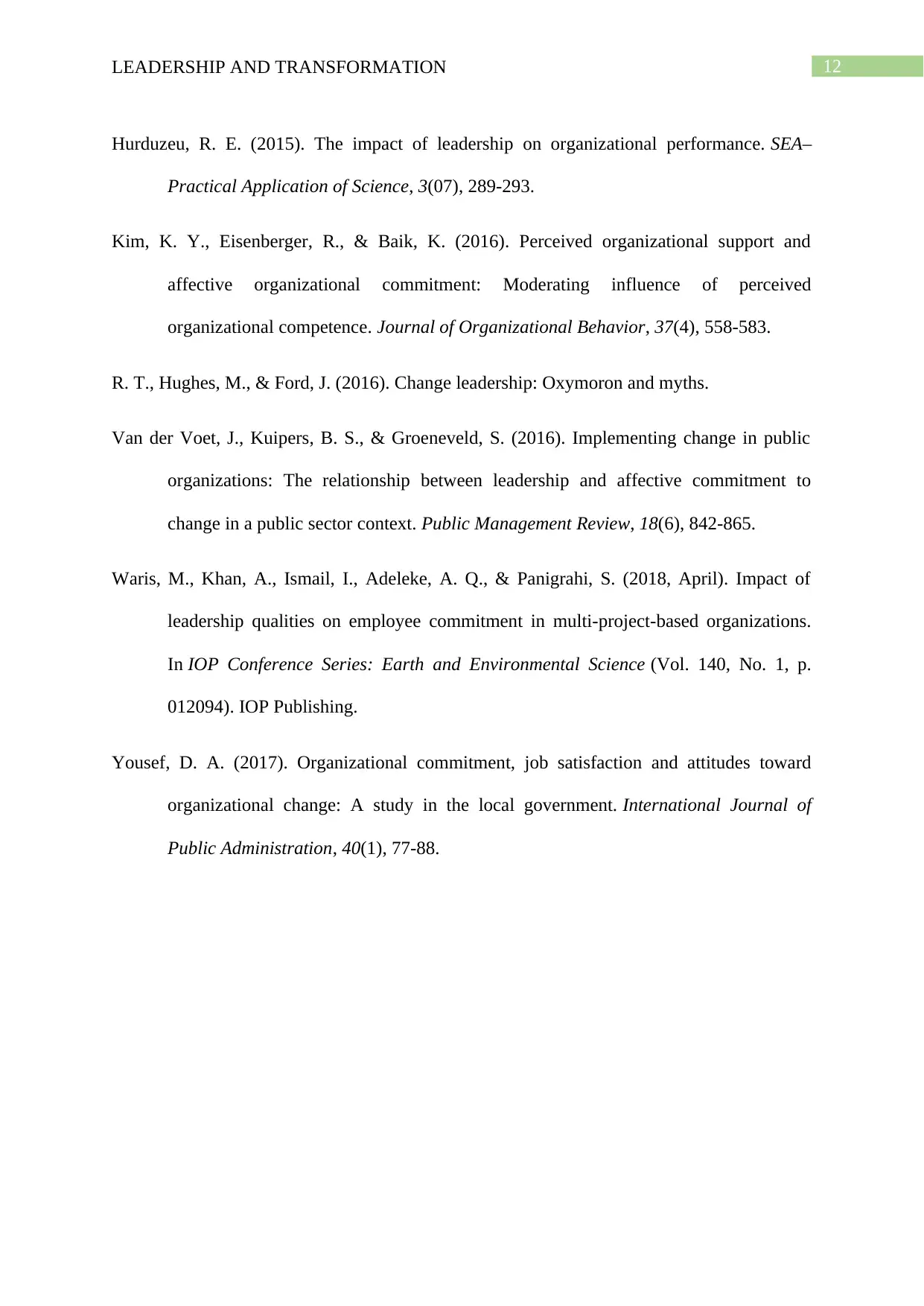
12LEADERSHIP AND TRANSFORMATION
Hurduzeu, R. E. (2015). The impact of leadership on organizational performance. SEA–
Practical Application of Science, 3(07), 289-293.
Kim, K. Y., Eisenberger, R., & Baik, K. (2016). Perceived organizational support and
affective organizational commitment: Moderating influence of perceived
organizational competence. Journal of Organizational Behavior, 37(4), 558-583.
R. T., Hughes, M., & Ford, J. (2016). Change leadership: Oxymoron and myths.
Van der Voet, J., Kuipers, B. S., & Groeneveld, S. (2016). Implementing change in public
organizations: The relationship between leadership and affective commitment to
change in a public sector context. Public Management Review, 18(6), 842-865.
Waris, M., Khan, A., Ismail, I., Adeleke, A. Q., & Panigrahi, S. (2018, April). Impact of
leadership qualities on employee commitment in multi-project-based organizations.
In IOP Conference Series: Earth and Environmental Science (Vol. 140, No. 1, p.
012094). IOP Publishing.
Yousef, D. A. (2017). Organizational commitment, job satisfaction and attitudes toward
organizational change: A study in the local government. International Journal of
Public Administration, 40(1), 77-88.
Hurduzeu, R. E. (2015). The impact of leadership on organizational performance. SEA–
Practical Application of Science, 3(07), 289-293.
Kim, K. Y., Eisenberger, R., & Baik, K. (2016). Perceived organizational support and
affective organizational commitment: Moderating influence of perceived
organizational competence. Journal of Organizational Behavior, 37(4), 558-583.
R. T., Hughes, M., & Ford, J. (2016). Change leadership: Oxymoron and myths.
Van der Voet, J., Kuipers, B. S., & Groeneveld, S. (2016). Implementing change in public
organizations: The relationship between leadership and affective commitment to
change in a public sector context. Public Management Review, 18(6), 842-865.
Waris, M., Khan, A., Ismail, I., Adeleke, A. Q., & Panigrahi, S. (2018, April). Impact of
leadership qualities on employee commitment in multi-project-based organizations.
In IOP Conference Series: Earth and Environmental Science (Vol. 140, No. 1, p.
012094). IOP Publishing.
Yousef, D. A. (2017). Organizational commitment, job satisfaction and attitudes toward
organizational change: A study in the local government. International Journal of
Public Administration, 40(1), 77-88.
Paraphrase This Document
Need a fresh take? Get an instant paraphrase of this document with our AI Paraphraser
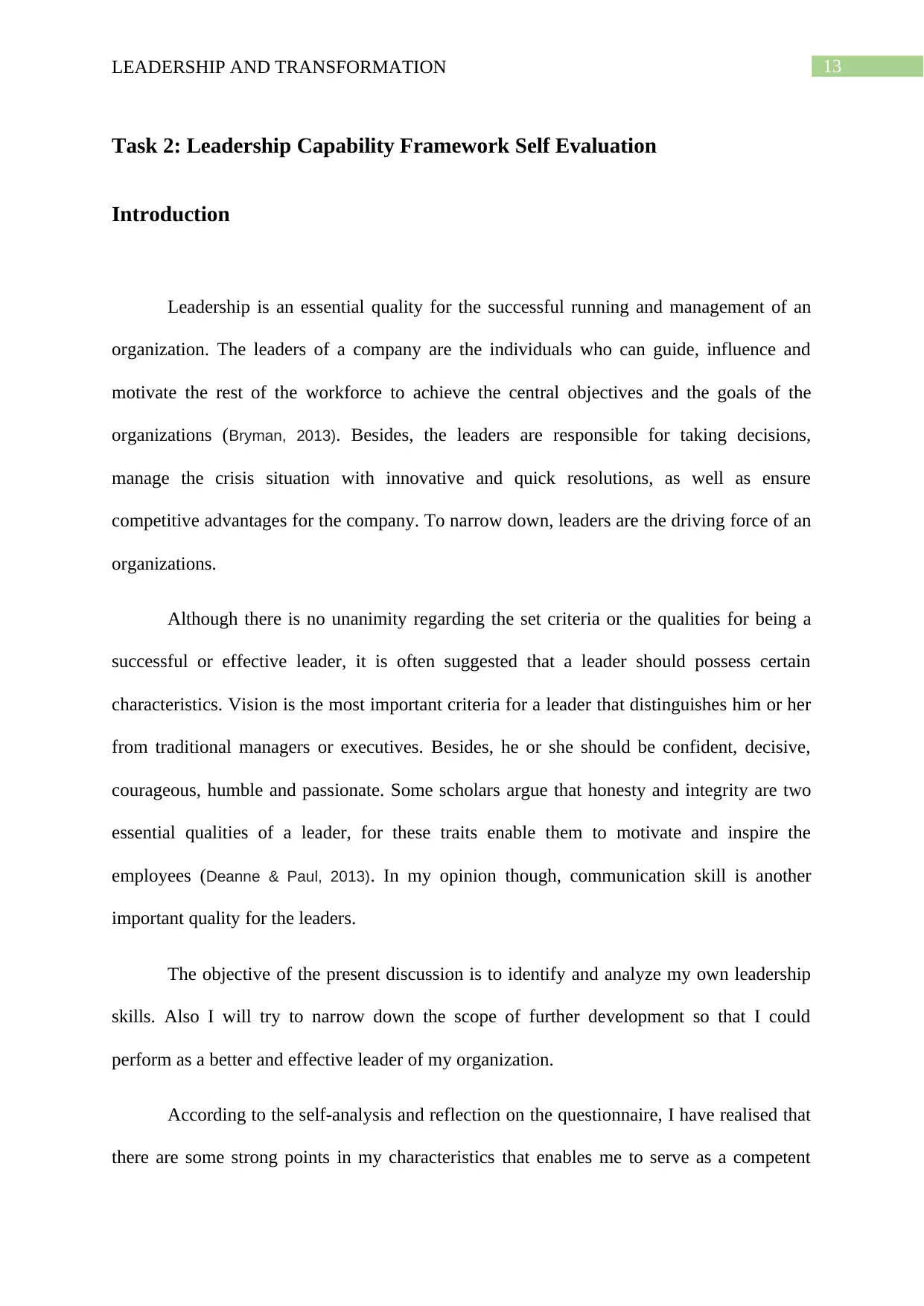
13LEADERSHIP AND TRANSFORMATION
Task 2: Leadership Capability Framework Self Evaluation
Introduction
Leadership is an essential quality for the successful running and management of an
organization. The leaders of a company are the individuals who can guide, influence and
motivate the rest of the workforce to achieve the central objectives and the goals of the
organizations (Bryman, 2013). Besides, the leaders are responsible for taking decisions,
manage the crisis situation with innovative and quick resolutions, as well as ensure
competitive advantages for the company. To narrow down, leaders are the driving force of an
organizations.
Although there is no unanimity regarding the set criteria or the qualities for being a
successful or effective leader, it is often suggested that a leader should possess certain
characteristics. Vision is the most important criteria for a leader that distinguishes him or her
from traditional managers or executives. Besides, he or she should be confident, decisive,
courageous, humble and passionate. Some scholars argue that honesty and integrity are two
essential qualities of a leader, for these traits enable them to motivate and inspire the
employees (Deanne & Paul, 2013). In my opinion though, communication skill is another
important quality for the leaders.
The objective of the present discussion is to identify and analyze my own leadership
skills. Also I will try to narrow down the scope of further development so that I could
perform as a better and effective leader of my organization.
According to the self-analysis and reflection on the questionnaire, I have realised that
there are some strong points in my characteristics that enables me to serve as a competent
Task 2: Leadership Capability Framework Self Evaluation
Introduction
Leadership is an essential quality for the successful running and management of an
organization. The leaders of a company are the individuals who can guide, influence and
motivate the rest of the workforce to achieve the central objectives and the goals of the
organizations (Bryman, 2013). Besides, the leaders are responsible for taking decisions,
manage the crisis situation with innovative and quick resolutions, as well as ensure
competitive advantages for the company. To narrow down, leaders are the driving force of an
organizations.
Although there is no unanimity regarding the set criteria or the qualities for being a
successful or effective leader, it is often suggested that a leader should possess certain
characteristics. Vision is the most important criteria for a leader that distinguishes him or her
from traditional managers or executives. Besides, he or she should be confident, decisive,
courageous, humble and passionate. Some scholars argue that honesty and integrity are two
essential qualities of a leader, for these traits enable them to motivate and inspire the
employees (Deanne & Paul, 2013). In my opinion though, communication skill is another
important quality for the leaders.
The objective of the present discussion is to identify and analyze my own leadership
skills. Also I will try to narrow down the scope of further development so that I could
perform as a better and effective leader of my organization.
According to the self-analysis and reflection on the questionnaire, I have realised that
there are some strong points in my characteristics that enables me to serve as a competent
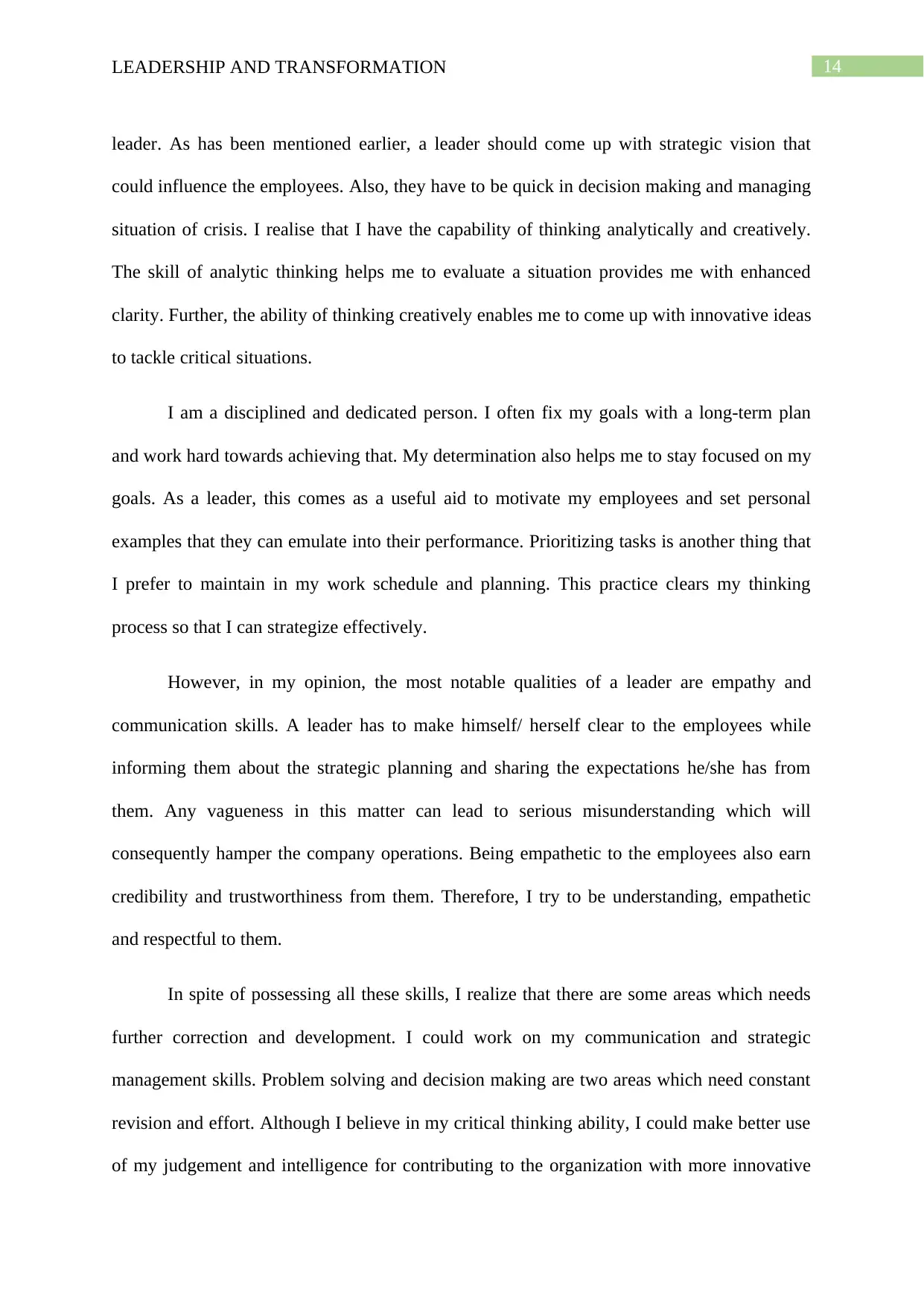
14LEADERSHIP AND TRANSFORMATION
leader. As has been mentioned earlier, a leader should come up with strategic vision that
could influence the employees. Also, they have to be quick in decision making and managing
situation of crisis. I realise that I have the capability of thinking analytically and creatively.
The skill of analytic thinking helps me to evaluate a situation provides me with enhanced
clarity. Further, the ability of thinking creatively enables me to come up with innovative ideas
to tackle critical situations.
I am a disciplined and dedicated person. I often fix my goals with a long-term plan
and work hard towards achieving that. My determination also helps me to stay focused on my
goals. As a leader, this comes as a useful aid to motivate my employees and set personal
examples that they can emulate into their performance. Prioritizing tasks is another thing that
I prefer to maintain in my work schedule and planning. This practice clears my thinking
process so that I can strategize effectively.
However, in my opinion, the most notable qualities of a leader are empathy and
communication skills. A leader has to make himself/ herself clear to the employees while
informing them about the strategic planning and sharing the expectations he/she has from
them. Any vagueness in this matter can lead to serious misunderstanding which will
consequently hamper the company operations. Being empathetic to the employees also earn
credibility and trustworthiness from them. Therefore, I try to be understanding, empathetic
and respectful to them.
In spite of possessing all these skills, I realize that there are some areas which needs
further correction and development. I could work on my communication and strategic
management skills. Problem solving and decision making are two areas which need constant
revision and effort. Although I believe in my critical thinking ability, I could make better use
of my judgement and intelligence for contributing to the organization with more innovative
leader. As has been mentioned earlier, a leader should come up with strategic vision that
could influence the employees. Also, they have to be quick in decision making and managing
situation of crisis. I realise that I have the capability of thinking analytically and creatively.
The skill of analytic thinking helps me to evaluate a situation provides me with enhanced
clarity. Further, the ability of thinking creatively enables me to come up with innovative ideas
to tackle critical situations.
I am a disciplined and dedicated person. I often fix my goals with a long-term plan
and work hard towards achieving that. My determination also helps me to stay focused on my
goals. As a leader, this comes as a useful aid to motivate my employees and set personal
examples that they can emulate into their performance. Prioritizing tasks is another thing that
I prefer to maintain in my work schedule and planning. This practice clears my thinking
process so that I can strategize effectively.
However, in my opinion, the most notable qualities of a leader are empathy and
communication skills. A leader has to make himself/ herself clear to the employees while
informing them about the strategic planning and sharing the expectations he/she has from
them. Any vagueness in this matter can lead to serious misunderstanding which will
consequently hamper the company operations. Being empathetic to the employees also earn
credibility and trustworthiness from them. Therefore, I try to be understanding, empathetic
and respectful to them.
In spite of possessing all these skills, I realize that there are some areas which needs
further correction and development. I could work on my communication and strategic
management skills. Problem solving and decision making are two areas which need constant
revision and effort. Although I believe in my critical thinking ability, I could make better use
of my judgement and intelligence for contributing to the organization with more innovative
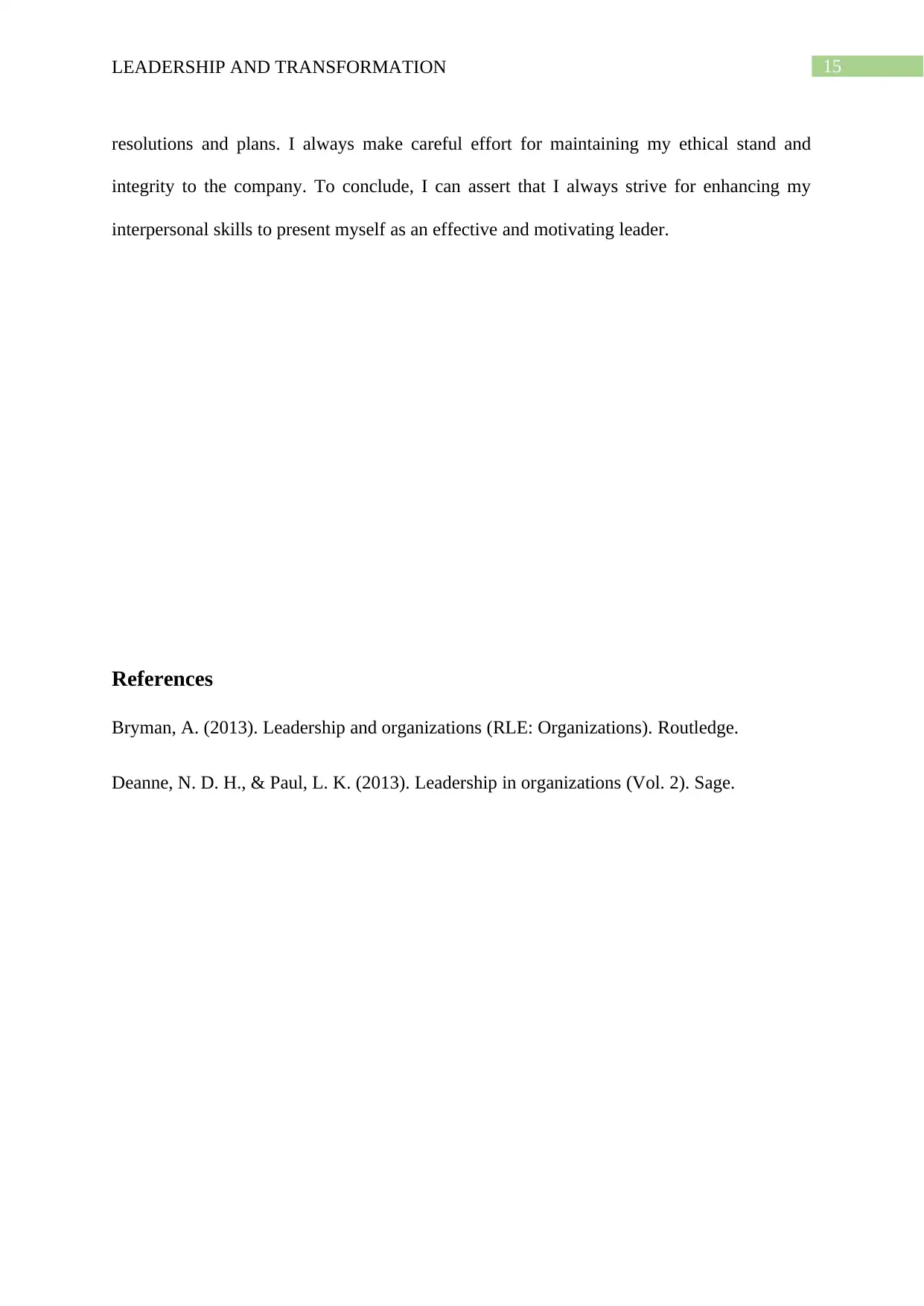
15LEADERSHIP AND TRANSFORMATION
resolutions and plans. I always make careful effort for maintaining my ethical stand and
integrity to the company. To conclude, I can assert that I always strive for enhancing my
interpersonal skills to present myself as an effective and motivating leader.
References
Bryman, A. (2013). Leadership and organizations (RLE: Organizations). Routledge.
Deanne, N. D. H., & Paul, L. K. (2013). Leadership in organizations (Vol. 2). Sage.
resolutions and plans. I always make careful effort for maintaining my ethical stand and
integrity to the company. To conclude, I can assert that I always strive for enhancing my
interpersonal skills to present myself as an effective and motivating leader.
References
Bryman, A. (2013). Leadership and organizations (RLE: Organizations). Routledge.
Deanne, N. D. H., & Paul, L. K. (2013). Leadership in organizations (Vol. 2). Sage.
Secure Best Marks with AI Grader
Need help grading? Try our AI Grader for instant feedback on your assignments.
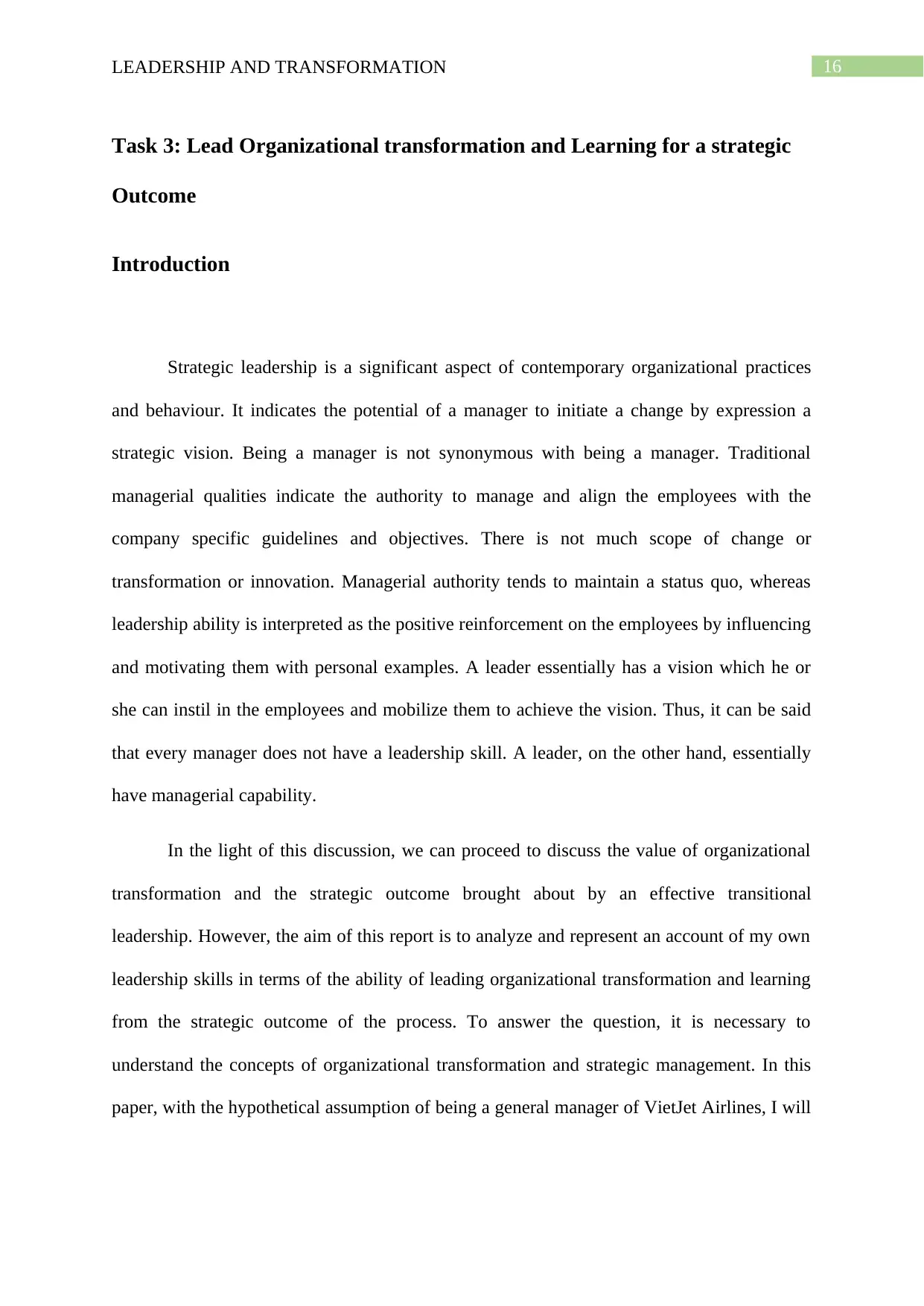
16LEADERSHIP AND TRANSFORMATION
Task 3: Lead Organizational transformation and Learning for a strategic
Outcome
Introduction
Strategic leadership is a significant aspect of contemporary organizational practices
and behaviour. It indicates the potential of a manager to initiate a change by expression a
strategic vision. Being a manager is not synonymous with being a manager. Traditional
managerial qualities indicate the authority to manage and align the employees with the
company specific guidelines and objectives. There is not much scope of change or
transformation or innovation. Managerial authority tends to maintain a status quo, whereas
leadership ability is interpreted as the positive reinforcement on the employees by influencing
and motivating them with personal examples. A leader essentially has a vision which he or
she can instil in the employees and mobilize them to achieve the vision. Thus, it can be said
that every manager does not have a leadership skill. A leader, on the other hand, essentially
have managerial capability.
In the light of this discussion, we can proceed to discuss the value of organizational
transformation and the strategic outcome brought about by an effective transitional
leadership. However, the aim of this report is to analyze and represent an account of my own
leadership skills in terms of the ability of leading organizational transformation and learning
from the strategic outcome of the process. To answer the question, it is necessary to
understand the concepts of organizational transformation and strategic management. In this
paper, with the hypothetical assumption of being a general manager of VietJet Airlines, I will
Task 3: Lead Organizational transformation and Learning for a strategic
Outcome
Introduction
Strategic leadership is a significant aspect of contemporary organizational practices
and behaviour. It indicates the potential of a manager to initiate a change by expression a
strategic vision. Being a manager is not synonymous with being a manager. Traditional
managerial qualities indicate the authority to manage and align the employees with the
company specific guidelines and objectives. There is not much scope of change or
transformation or innovation. Managerial authority tends to maintain a status quo, whereas
leadership ability is interpreted as the positive reinforcement on the employees by influencing
and motivating them with personal examples. A leader essentially has a vision which he or
she can instil in the employees and mobilize them to achieve the vision. Thus, it can be said
that every manager does not have a leadership skill. A leader, on the other hand, essentially
have managerial capability.
In the light of this discussion, we can proceed to discuss the value of organizational
transformation and the strategic outcome brought about by an effective transitional
leadership. However, the aim of this report is to analyze and represent an account of my own
leadership skills in terms of the ability of leading organizational transformation and learning
from the strategic outcome of the process. To answer the question, it is necessary to
understand the concepts of organizational transformation and strategic management. In this
paper, with the hypothetical assumption of being a general manager of VietJet Airlines, I will
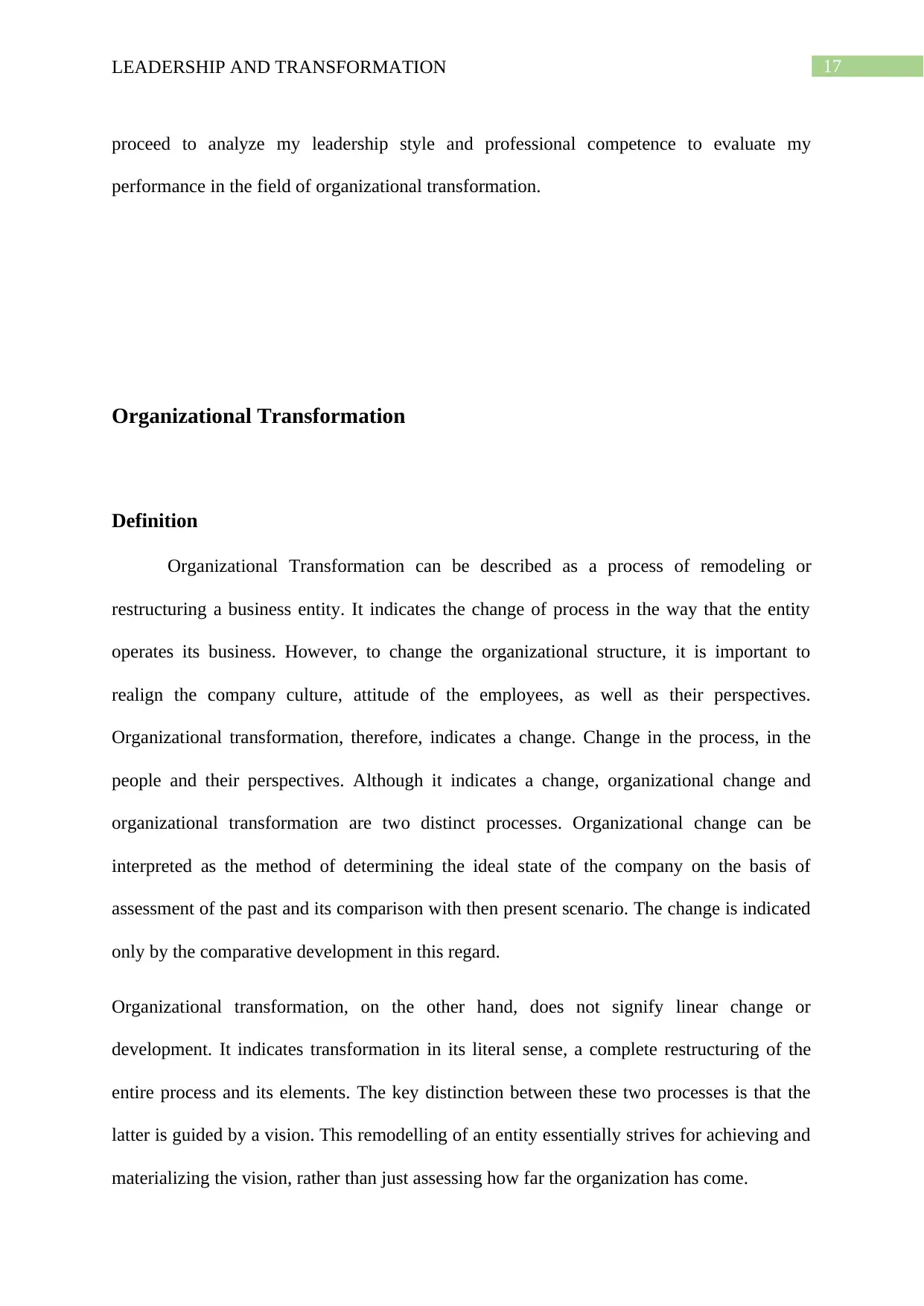
17LEADERSHIP AND TRANSFORMATION
proceed to analyze my leadership style and professional competence to evaluate my
performance in the field of organizational transformation.
Organizational Transformation
Definition
Organizational Transformation can be described as a process of remodeling or
restructuring a business entity. It indicates the change of process in the way that the entity
operates its business. However, to change the organizational structure, it is important to
realign the company culture, attitude of the employees, as well as their perspectives.
Organizational transformation, therefore, indicates a change. Change in the process, in the
people and their perspectives. Although it indicates a change, organizational change and
organizational transformation are two distinct processes. Organizational change can be
interpreted as the method of determining the ideal state of the company on the basis of
assessment of the past and its comparison with then present scenario. The change is indicated
only by the comparative development in this regard.
Organizational transformation, on the other hand, does not signify linear change or
development. It indicates transformation in its literal sense, a complete restructuring of the
entire process and its elements. The key distinction between these two processes is that the
latter is guided by a vision. This remodelling of an entity essentially strives for achieving and
materializing the vision, rather than just assessing how far the organization has come.
proceed to analyze my leadership style and professional competence to evaluate my
performance in the field of organizational transformation.
Organizational Transformation
Definition
Organizational Transformation can be described as a process of remodeling or
restructuring a business entity. It indicates the change of process in the way that the entity
operates its business. However, to change the organizational structure, it is important to
realign the company culture, attitude of the employees, as well as their perspectives.
Organizational transformation, therefore, indicates a change. Change in the process, in the
people and their perspectives. Although it indicates a change, organizational change and
organizational transformation are two distinct processes. Organizational change can be
interpreted as the method of determining the ideal state of the company on the basis of
assessment of the past and its comparison with then present scenario. The change is indicated
only by the comparative development in this regard.
Organizational transformation, on the other hand, does not signify linear change or
development. It indicates transformation in its literal sense, a complete restructuring of the
entire process and its elements. The key distinction between these two processes is that the
latter is guided by a vision. This remodelling of an entity essentially strives for achieving and
materializing the vision, rather than just assessing how far the organization has come.
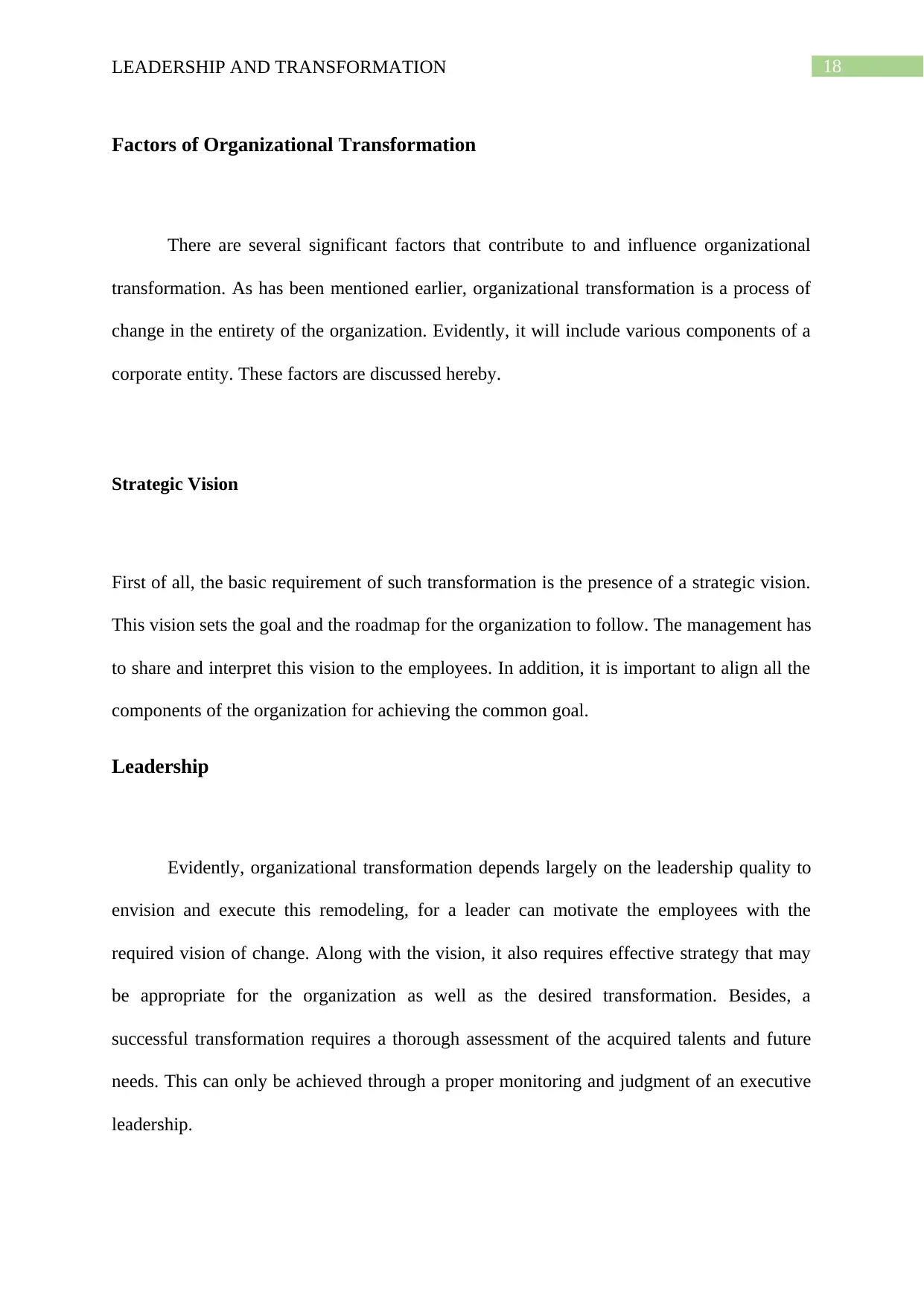
18LEADERSHIP AND TRANSFORMATION
Factors of Organizational Transformation
There are several significant factors that contribute to and influence organizational
transformation. As has been mentioned earlier, organizational transformation is a process of
change in the entirety of the organization. Evidently, it will include various components of a
corporate entity. These factors are discussed hereby.
Strategic Vision
First of all, the basic requirement of such transformation is the presence of a strategic vision.
This vision sets the goal and the roadmap for the organization to follow. The management has
to share and interpret this vision to the employees. In addition, it is important to align all the
components of the organization for achieving the common goal.
Leadership
Evidently, organizational transformation depends largely on the leadership quality to
envision and execute this remodeling, for a leader can motivate the employees with the
required vision of change. Along with the vision, it also requires effective strategy that may
be appropriate for the organization as well as the desired transformation. Besides, a
successful transformation requires a thorough assessment of the acquired talents and future
needs. This can only be achieved through a proper monitoring and judgment of an executive
leadership.
Factors of Organizational Transformation
There are several significant factors that contribute to and influence organizational
transformation. As has been mentioned earlier, organizational transformation is a process of
change in the entirety of the organization. Evidently, it will include various components of a
corporate entity. These factors are discussed hereby.
Strategic Vision
First of all, the basic requirement of such transformation is the presence of a strategic vision.
This vision sets the goal and the roadmap for the organization to follow. The management has
to share and interpret this vision to the employees. In addition, it is important to align all the
components of the organization for achieving the common goal.
Leadership
Evidently, organizational transformation depends largely on the leadership quality to
envision and execute this remodeling, for a leader can motivate the employees with the
required vision of change. Along with the vision, it also requires effective strategy that may
be appropriate for the organization as well as the desired transformation. Besides, a
successful transformation requires a thorough assessment of the acquired talents and future
needs. This can only be achieved through a proper monitoring and judgment of an executive
leadership.
Paraphrase This Document
Need a fresh take? Get an instant paraphrase of this document with our AI Paraphraser

19LEADERSHIP AND TRANSFORMATION
Skill Development
Organizational transformation is largely dependent on the enhancement and
refinement of the organizational talent. Therefore, careful training design is imperative for
achieving the desired result from the talent pool. This design in turn requires a thorough
assessment of the current skill and future needs. Moreover, this design should cater to the
various needs of the employees, for every individual has a different and unique set of skills.
Integration of Existing and Targeted Culture
The transformation can only be successful if the existing practices and the culture of
the organization does not contradict the targeted ones. In other words, every organization has
a peculiar environment and values. To attain a strategic transformation, the set goals and
guidelines correspond to those values. Or else, the positional shift has to be made clear to the
stakeholders to avoid any kind of miscommunication. Moreover, the organization should be
willing and ready to embrace the change. Else, conflict of perspectives and interests will
ultimately hamper the outcome.
Learning from a Strategic Outcome
Strategic outcome is the desired end result or societal state to which an organization
devotes it efforts and planning. It can be interpreted as the consequence of a planned
operation within the organizational structure. To master the art of leadership, a manager has
to learn from this outcome and assess the impacts of such strategic change. Therefore, it can
be asserted that learning from the consequences is an essential quality of a leader, for it gives
Skill Development
Organizational transformation is largely dependent on the enhancement and
refinement of the organizational talent. Therefore, careful training design is imperative for
achieving the desired result from the talent pool. This design in turn requires a thorough
assessment of the current skill and future needs. Moreover, this design should cater to the
various needs of the employees, for every individual has a different and unique set of skills.
Integration of Existing and Targeted Culture
The transformation can only be successful if the existing practices and the culture of
the organization does not contradict the targeted ones. In other words, every organization has
a peculiar environment and values. To attain a strategic transformation, the set goals and
guidelines correspond to those values. Or else, the positional shift has to be made clear to the
stakeholders to avoid any kind of miscommunication. Moreover, the organization should be
willing and ready to embrace the change. Else, conflict of perspectives and interests will
ultimately hamper the outcome.
Learning from a Strategic Outcome
Strategic outcome is the desired end result or societal state to which an organization
devotes it efforts and planning. It can be interpreted as the consequence of a planned
operation within the organizational structure. To master the art of leadership, a manager has
to learn from this outcome and assess the impacts of such strategic change. Therefore, it can
be asserted that learning from the consequences is an essential quality of a leader, for it gives
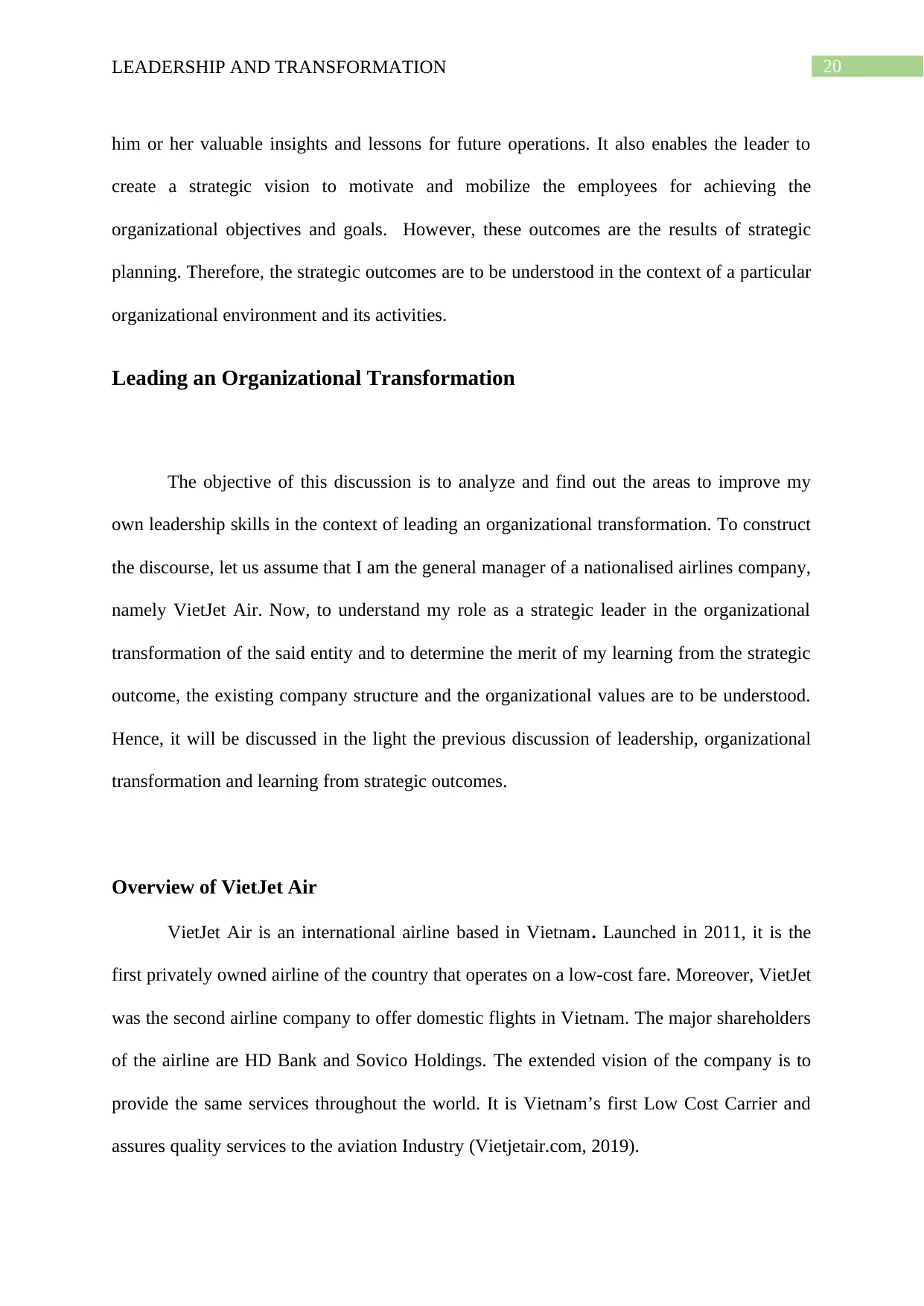
20LEADERSHIP AND TRANSFORMATION
him or her valuable insights and lessons for future operations. It also enables the leader to
create a strategic vision to motivate and mobilize the employees for achieving the
organizational objectives and goals. However, these outcomes are the results of strategic
planning. Therefore, the strategic outcomes are to be understood in the context of a particular
organizational environment and its activities.
Leading an Organizational Transformation
The objective of this discussion is to analyze and find out the areas to improve my
own leadership skills in the context of leading an organizational transformation. To construct
the discourse, let us assume that I am the general manager of a nationalised airlines company,
namely VietJet Air. Now, to understand my role as a strategic leader in the organizational
transformation of the said entity and to determine the merit of my learning from the strategic
outcome, the existing company structure and the organizational values are to be understood.
Hence, it will be discussed in the light the previous discussion of leadership, organizational
transformation and learning from strategic outcomes.
Overview of VietJet Air
VietJet Air is an international airline based in Vietnam. Launched in 2011, it is the
first privately owned airline of the country that operates on a low-cost fare. Moreover, VietJet
was the second airline company to offer domestic flights in Vietnam. The major shareholders
of the airline are HD Bank and Sovico Holdings. The extended vision of the company is to
provide the same services throughout the world. It is Vietnam’s first Low Cost Carrier and
assures quality services to the aviation Industry (Vietjetair.com, 2019).
him or her valuable insights and lessons for future operations. It also enables the leader to
create a strategic vision to motivate and mobilize the employees for achieving the
organizational objectives and goals. However, these outcomes are the results of strategic
planning. Therefore, the strategic outcomes are to be understood in the context of a particular
organizational environment and its activities.
Leading an Organizational Transformation
The objective of this discussion is to analyze and find out the areas to improve my
own leadership skills in the context of leading an organizational transformation. To construct
the discourse, let us assume that I am the general manager of a nationalised airlines company,
namely VietJet Air. Now, to understand my role as a strategic leader in the organizational
transformation of the said entity and to determine the merit of my learning from the strategic
outcome, the existing company structure and the organizational values are to be understood.
Hence, it will be discussed in the light the previous discussion of leadership, organizational
transformation and learning from strategic outcomes.
Overview of VietJet Air
VietJet Air is an international airline based in Vietnam. Launched in 2011, it is the
first privately owned airline of the country that operates on a low-cost fare. Moreover, VietJet
was the second airline company to offer domestic flights in Vietnam. The major shareholders
of the airline are HD Bank and Sovico Holdings. The extended vision of the company is to
provide the same services throughout the world. It is Vietnam’s first Low Cost Carrier and
assures quality services to the aviation Industry (Vietjetair.com, 2019).
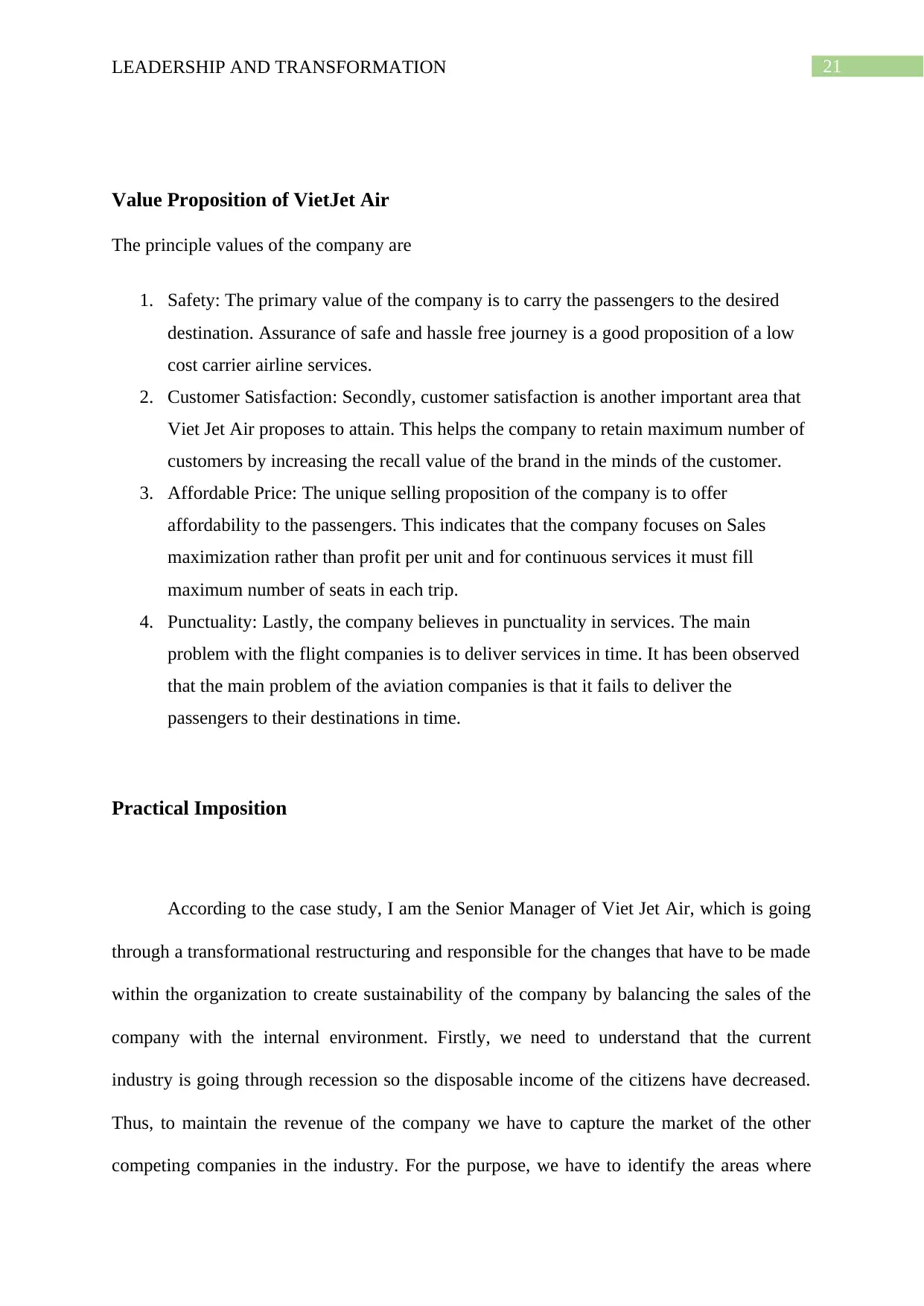
21LEADERSHIP AND TRANSFORMATION
Value Proposition of VietJet Air
The principle values of the company are
1. Safety: The primary value of the company is to carry the passengers to the desired
destination. Assurance of safe and hassle free journey is a good proposition of a low
cost carrier airline services.
2. Customer Satisfaction: Secondly, customer satisfaction is another important area that
Viet Jet Air proposes to attain. This helps the company to retain maximum number of
customers by increasing the recall value of the brand in the minds of the customer.
3. Affordable Price: The unique selling proposition of the company is to offer
affordability to the passengers. This indicates that the company focuses on Sales
maximization rather than profit per unit and for continuous services it must fill
maximum number of seats in each trip.
4. Punctuality: Lastly, the company believes in punctuality in services. The main
problem with the flight companies is to deliver services in time. It has been observed
that the main problem of the aviation companies is that it fails to deliver the
passengers to their destinations in time.
Practical Imposition
According to the case study, I am the Senior Manager of Viet Jet Air, which is going
through a transformational restructuring and responsible for the changes that have to be made
within the organization to create sustainability of the company by balancing the sales of the
company with the internal environment. Firstly, we need to understand that the current
industry is going through recession so the disposable income of the citizens have decreased.
Thus, to maintain the revenue of the company we have to capture the market of the other
competing companies in the industry. For the purpose, we have to identify the areas where
Value Proposition of VietJet Air
The principle values of the company are
1. Safety: The primary value of the company is to carry the passengers to the desired
destination. Assurance of safe and hassle free journey is a good proposition of a low
cost carrier airline services.
2. Customer Satisfaction: Secondly, customer satisfaction is another important area that
Viet Jet Air proposes to attain. This helps the company to retain maximum number of
customers by increasing the recall value of the brand in the minds of the customer.
3. Affordable Price: The unique selling proposition of the company is to offer
affordability to the passengers. This indicates that the company focuses on Sales
maximization rather than profit per unit and for continuous services it must fill
maximum number of seats in each trip.
4. Punctuality: Lastly, the company believes in punctuality in services. The main
problem with the flight companies is to deliver services in time. It has been observed
that the main problem of the aviation companies is that it fails to deliver the
passengers to their destinations in time.
Practical Imposition
According to the case study, I am the Senior Manager of Viet Jet Air, which is going
through a transformational restructuring and responsible for the changes that have to be made
within the organization to create sustainability of the company by balancing the sales of the
company with the internal environment. Firstly, we need to understand that the current
industry is going through recession so the disposable income of the citizens have decreased.
Thus, to maintain the revenue of the company we have to capture the market of the other
competing companies in the industry. For the purpose, we have to identify the areas where
Secure Best Marks with AI Grader
Need help grading? Try our AI Grader for instant feedback on your assignments.
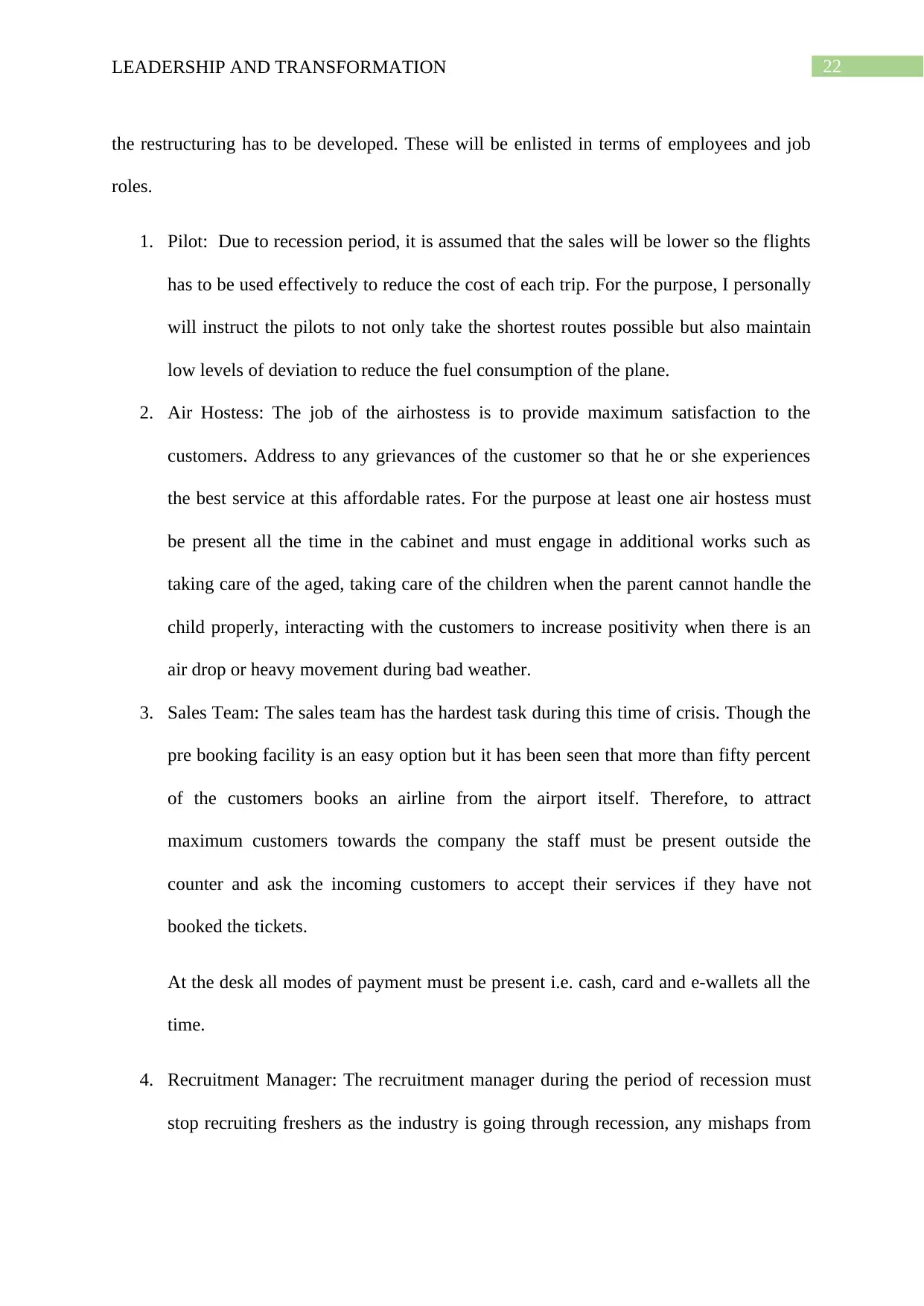
22LEADERSHIP AND TRANSFORMATION
the restructuring has to be developed. These will be enlisted in terms of employees and job
roles.
1. Pilot: Due to recession period, it is assumed that the sales will be lower so the flights
has to be used effectively to reduce the cost of each trip. For the purpose, I personally
will instruct the pilots to not only take the shortest routes possible but also maintain
low levels of deviation to reduce the fuel consumption of the plane.
2. Air Hostess: The job of the airhostess is to provide maximum satisfaction to the
customers. Address to any grievances of the customer so that he or she experiences
the best service at this affordable rates. For the purpose at least one air hostess must
be present all the time in the cabinet and must engage in additional works such as
taking care of the aged, taking care of the children when the parent cannot handle the
child properly, interacting with the customers to increase positivity when there is an
air drop or heavy movement during bad weather.
3. Sales Team: The sales team has the hardest task during this time of crisis. Though the
pre booking facility is an easy option but it has been seen that more than fifty percent
of the customers books an airline from the airport itself. Therefore, to attract
maximum customers towards the company the staff must be present outside the
counter and ask the incoming customers to accept their services if they have not
booked the tickets.
At the desk all modes of payment must be present i.e. cash, card and e-wallets all the
time.
4. Recruitment Manager: The recruitment manager during the period of recession must
stop recruiting freshers as the industry is going through recession, any mishaps from
the restructuring has to be developed. These will be enlisted in terms of employees and job
roles.
1. Pilot: Due to recession period, it is assumed that the sales will be lower so the flights
has to be used effectively to reduce the cost of each trip. For the purpose, I personally
will instruct the pilots to not only take the shortest routes possible but also maintain
low levels of deviation to reduce the fuel consumption of the plane.
2. Air Hostess: The job of the airhostess is to provide maximum satisfaction to the
customers. Address to any grievances of the customer so that he or she experiences
the best service at this affordable rates. For the purpose at least one air hostess must
be present all the time in the cabinet and must engage in additional works such as
taking care of the aged, taking care of the children when the parent cannot handle the
child properly, interacting with the customers to increase positivity when there is an
air drop or heavy movement during bad weather.
3. Sales Team: The sales team has the hardest task during this time of crisis. Though the
pre booking facility is an easy option but it has been seen that more than fifty percent
of the customers books an airline from the airport itself. Therefore, to attract
maximum customers towards the company the staff must be present outside the
counter and ask the incoming customers to accept their services if they have not
booked the tickets.
At the desk all modes of payment must be present i.e. cash, card and e-wallets all the
time.
4. Recruitment Manager: The recruitment manager during the period of recession must
stop recruiting freshers as the industry is going through recession, any mishaps from
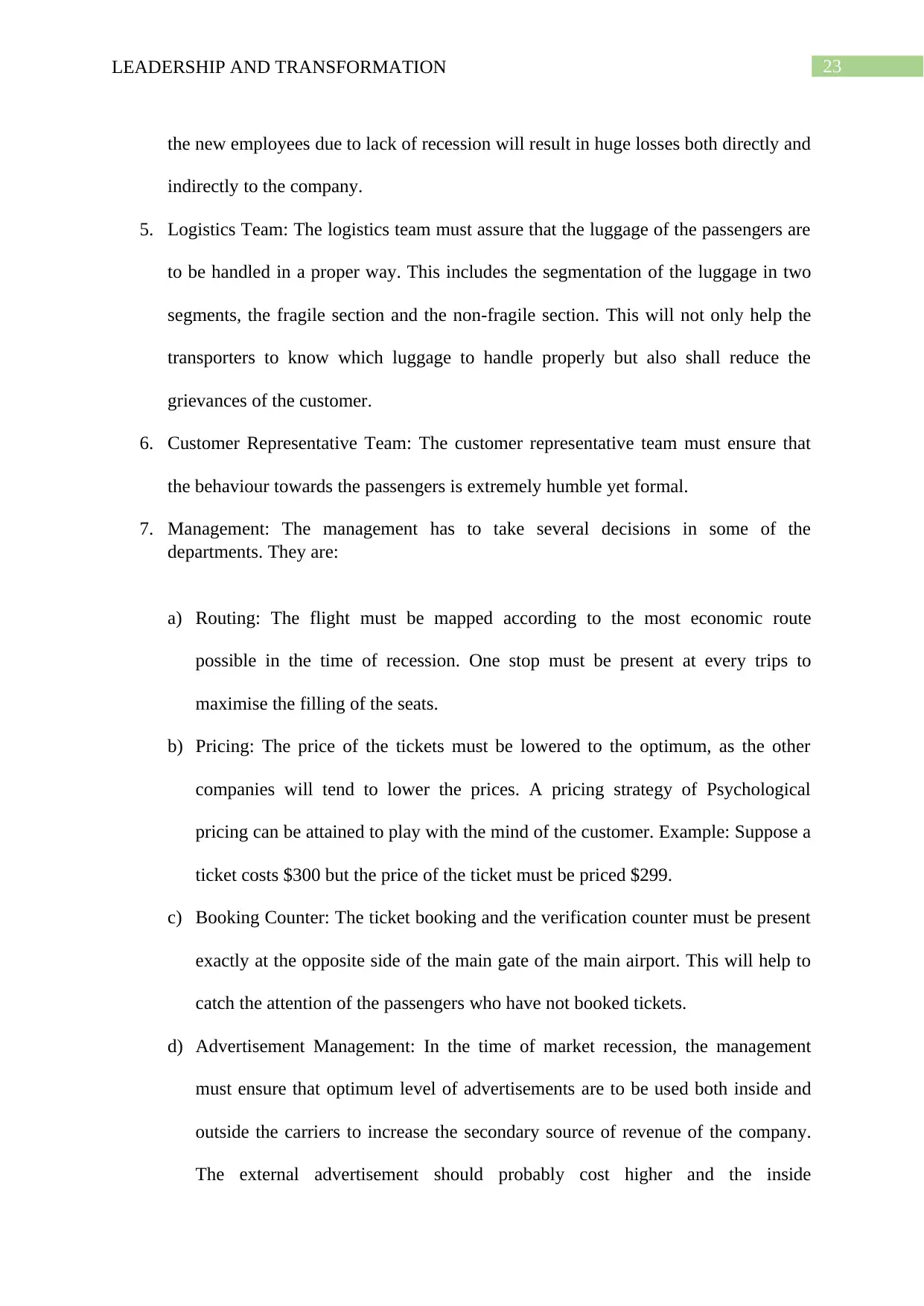
23LEADERSHIP AND TRANSFORMATION
the new employees due to lack of recession will result in huge losses both directly and
indirectly to the company.
5. Logistics Team: The logistics team must assure that the luggage of the passengers are
to be handled in a proper way. This includes the segmentation of the luggage in two
segments, the fragile section and the non-fragile section. This will not only help the
transporters to know which luggage to handle properly but also shall reduce the
grievances of the customer.
6. Customer Representative Team: The customer representative team must ensure that
the behaviour towards the passengers is extremely humble yet formal.
7. Management: The management has to take several decisions in some of the
departments. They are:
a) Routing: The flight must be mapped according to the most economic route
possible in the time of recession. One stop must be present at every trips to
maximise the filling of the seats.
b) Pricing: The price of the tickets must be lowered to the optimum, as the other
companies will tend to lower the prices. A pricing strategy of Psychological
pricing can be attained to play with the mind of the customer. Example: Suppose a
ticket costs $300 but the price of the ticket must be priced $299.
c) Booking Counter: The ticket booking and the verification counter must be present
exactly at the opposite side of the main gate of the main airport. This will help to
catch the attention of the passengers who have not booked tickets.
d) Advertisement Management: In the time of market recession, the management
must ensure that optimum level of advertisements are to be used both inside and
outside the carriers to increase the secondary source of revenue of the company.
The external advertisement should probably cost higher and the inside
the new employees due to lack of recession will result in huge losses both directly and
indirectly to the company.
5. Logistics Team: The logistics team must assure that the luggage of the passengers are
to be handled in a proper way. This includes the segmentation of the luggage in two
segments, the fragile section and the non-fragile section. This will not only help the
transporters to know which luggage to handle properly but also shall reduce the
grievances of the customer.
6. Customer Representative Team: The customer representative team must ensure that
the behaviour towards the passengers is extremely humble yet formal.
7. Management: The management has to take several decisions in some of the
departments. They are:
a) Routing: The flight must be mapped according to the most economic route
possible in the time of recession. One stop must be present at every trips to
maximise the filling of the seats.
b) Pricing: The price of the tickets must be lowered to the optimum, as the other
companies will tend to lower the prices. A pricing strategy of Psychological
pricing can be attained to play with the mind of the customer. Example: Suppose a
ticket costs $300 but the price of the ticket must be priced $299.
c) Booking Counter: The ticket booking and the verification counter must be present
exactly at the opposite side of the main gate of the main airport. This will help to
catch the attention of the passengers who have not booked tickets.
d) Advertisement Management: In the time of market recession, the management
must ensure that optimum level of advertisements are to be used both inside and
outside the carriers to increase the secondary source of revenue of the company.
The external advertisement should probably cost higher and the inside

24LEADERSHIP AND TRANSFORMATION
advertisements must cost lower but that totally depends on how much time the
customer is engaged with the advertisement.
Role of Transformational Leadership to align the Ideas with Reality
1. Individualized Consideration: The primary aspect to be taken into account at this
time is to be an individual leader and go by self-knowledge and experience. To
achieve the task, I have to be more vocal and open to the problems of the people
as well as the employees. I have to segregate the employees according to the talent
they possess. The vocal staff must be present in the customer interaction areas
such as the help desk and cabin crew. Transparency must be achieved through
open communication and employees must be motivated to rely on the decisions
taken to fulfil the task.
2. Intellectual Stimulation: As the aviation industry is very dynamic in nature, I as a
senior manager must be prepared with all predictable challenges. All the expected
grievances must be predicted and instant solutions to the problems must be present
to reduce the grievances of any stakeholder. Innovating plans and ideas must be
attained at this time of recession.
3. Inspirational Motivation: The time of recession in the aviation industry is
dreadful. So I, as a manager firstly must handle myself effectively and try to
position my mind as assertive as possible. On the other hand, both negative and
positive motivation has to be used according to the requirement of the employees.
advertisements must cost lower but that totally depends on how much time the
customer is engaged with the advertisement.
Role of Transformational Leadership to align the Ideas with Reality
1. Individualized Consideration: The primary aspect to be taken into account at this
time is to be an individual leader and go by self-knowledge and experience. To
achieve the task, I have to be more vocal and open to the problems of the people
as well as the employees. I have to segregate the employees according to the talent
they possess. The vocal staff must be present in the customer interaction areas
such as the help desk and cabin crew. Transparency must be achieved through
open communication and employees must be motivated to rely on the decisions
taken to fulfil the task.
2. Intellectual Stimulation: As the aviation industry is very dynamic in nature, I as a
senior manager must be prepared with all predictable challenges. All the expected
grievances must be predicted and instant solutions to the problems must be present
to reduce the grievances of any stakeholder. Innovating plans and ideas must be
attained at this time of recession.
3. Inspirational Motivation: The time of recession in the aviation industry is
dreadful. So I, as a manager firstly must handle myself effectively and try to
position my mind as assertive as possible. On the other hand, both negative and
positive motivation has to be used according to the requirement of the employees.
Paraphrase This Document
Need a fresh take? Get an instant paraphrase of this document with our AI Paraphraser

25LEADERSHIP AND TRANSFORMATION
4. Idealized Influence: The team, which is currently working under my expertise,
must see me as a role model and must follow all my instructions like the rulebook.
Therefore, to position my authority and respect on the employees I must be
inspiring, motivating and an individual who is addressed when there is a
requirement of a major solution.
Conclusion
To sum up, it can be said from the discussion that during an organizational
transformation, the management of a company needs to carefully design the strategy and
planning for an effective outcome. The management requires taking an influential stand so
that the employees can be aligned with the revised strategic planning and vision. Therefore,
transformational leadership style is an obvious choice in this scenario, for this particular style
of leadership can provide valuable insights and strategic vision that can motivate and
mobilize the employees. In this regard, assessing the personal leadership skill is important.
Besides, learning from the strategic outcome also is an essential step to achieve a successful
change in the organization, for it enables the entity to determine future strategies to attain
success.
4. Idealized Influence: The team, which is currently working under my expertise,
must see me as a role model and must follow all my instructions like the rulebook.
Therefore, to position my authority and respect on the employees I must be
inspiring, motivating and an individual who is addressed when there is a
requirement of a major solution.
Conclusion
To sum up, it can be said from the discussion that during an organizational
transformation, the management of a company needs to carefully design the strategy and
planning for an effective outcome. The management requires taking an influential stand so
that the employees can be aligned with the revised strategic planning and vision. Therefore,
transformational leadership style is an obvious choice in this scenario, for this particular style
of leadership can provide valuable insights and strategic vision that can motivate and
mobilize the employees. In this regard, assessing the personal leadership skill is important.
Besides, learning from the strategic outcome also is an essential step to achieve a successful
change in the organization, for it enables the entity to determine future strategies to attain
success.
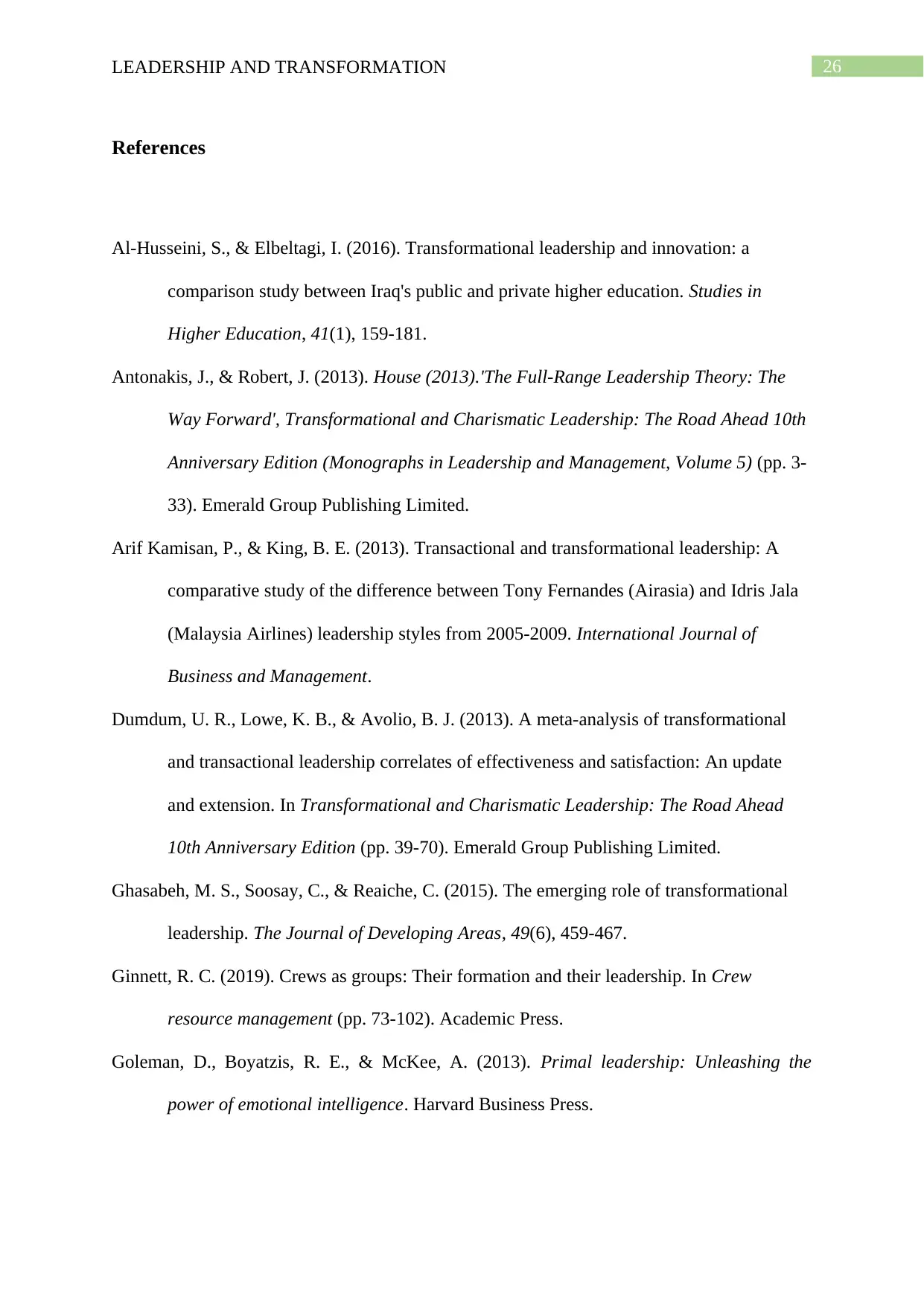
26LEADERSHIP AND TRANSFORMATION
References
Al-Husseini, S., & Elbeltagi, I. (2016). Transformational leadership and innovation: a
comparison study between Iraq's public and private higher education. Studies in
Higher Education, 41(1), 159-181.
Antonakis, J., & Robert, J. (2013). House (2013).'The Full-Range Leadership Theory: The
Way Forward', Transformational and Charismatic Leadership: The Road Ahead 10th
Anniversary Edition (Monographs in Leadership and Management, Volume 5) (pp. 3-
33). Emerald Group Publishing Limited.
Arif Kamisan, P., & King, B. E. (2013). Transactional and transformational leadership: A
comparative study of the difference between Tony Fernandes (Airasia) and Idris Jala
(Malaysia Airlines) leadership styles from 2005-2009. International Journal of
Business and Management.
Dumdum, U. R., Lowe, K. B., & Avolio, B. J. (2013). A meta-analysis of transformational
and transactional leadership correlates of effectiveness and satisfaction: An update
and extension. In Transformational and Charismatic Leadership: The Road Ahead
10th Anniversary Edition (pp. 39-70). Emerald Group Publishing Limited.
Ghasabeh, M. S., Soosay, C., & Reaiche, C. (2015). The emerging role of transformational
leadership. The Journal of Developing Areas, 49(6), 459-467.
Ginnett, R. C. (2019). Crews as groups: Their formation and their leadership. In Crew
resource management (pp. 73-102). Academic Press.
Goleman, D., Boyatzis, R. E., & McKee, A. (2013). Primal leadership: Unleashing the
power of emotional intelligence. Harvard Business Press.
References
Al-Husseini, S., & Elbeltagi, I. (2016). Transformational leadership and innovation: a
comparison study between Iraq's public and private higher education. Studies in
Higher Education, 41(1), 159-181.
Antonakis, J., & Robert, J. (2013). House (2013).'The Full-Range Leadership Theory: The
Way Forward', Transformational and Charismatic Leadership: The Road Ahead 10th
Anniversary Edition (Monographs in Leadership and Management, Volume 5) (pp. 3-
33). Emerald Group Publishing Limited.
Arif Kamisan, P., & King, B. E. (2013). Transactional and transformational leadership: A
comparative study of the difference between Tony Fernandes (Airasia) and Idris Jala
(Malaysia Airlines) leadership styles from 2005-2009. International Journal of
Business and Management.
Dumdum, U. R., Lowe, K. B., & Avolio, B. J. (2013). A meta-analysis of transformational
and transactional leadership correlates of effectiveness and satisfaction: An update
and extension. In Transformational and Charismatic Leadership: The Road Ahead
10th Anniversary Edition (pp. 39-70). Emerald Group Publishing Limited.
Ghasabeh, M. S., Soosay, C., & Reaiche, C. (2015). The emerging role of transformational
leadership. The Journal of Developing Areas, 49(6), 459-467.
Ginnett, R. C. (2019). Crews as groups: Their formation and their leadership. In Crew
resource management (pp. 73-102). Academic Press.
Goleman, D., Boyatzis, R. E., & McKee, A. (2013). Primal leadership: Unleashing the
power of emotional intelligence. Harvard Business Press.

27LEADERSHIP AND TRANSFORMATION
Hackman, M. Z., & Johnson, C. E. (2013). Leadership: A communication perspective.
Waveland Press.
Klaas, T., & Klein, J. (2017). Strategic airline positioning in the German low cost carrier
(LCC) market. In Strategic Management in the Aviation Industry (pp. 119-142).
Routledge.
Martin, K., & Osterling, M. (2014). Value stream mapping: how to visualize work and align
leadership for organizational transformation. New York, NY: McGraw-Hill.
Mayfield, J., Mayfield, M., & Sharbrough III, W. C. (2015). Strategic vision and values in
top leaders’ communications: Motivating language at a higher level. International
Journal of Business Communication, 52(1), 97-121.
Mayo, A., Nohria, N., & Rennella, M. (2016). Entrepreneurs, managers, and leaders: What
the airline industry can teach us about leadership. Springer.
McCleskey, J. A. (2014). Situational, transformational, and transactional leadership and
leadership development. Journal of Business Studies Quarterly, 5(4), 117.
Min, H., & Joo, S. J. (2016). A comparative performance analysis of airline strategic
alliances using data envelopment analysis. Journal of Air Transport Management, 52,
99-110.
Penava, S., & Šehić, D. (2014). THE RELEVANCE OF TRANSFORMATIONAL
LEADERSHIP IN SHAPING EMPLOYEE ATTITUDES TOWARDS
ORGANIZATIONAL CHANGE. Ekonomski Anali/Economic Annals, 59(200).
Stare, J., Pezdir, M., & Boštjančič, E. (2013). Links between perceived leadership styles and
self-reported coping strategies. Psihologijske teme, 22(3), 413-430.
Vietjetair.com. (2019). VietJetAir.com - Enjoy Flying!. Retrieved 10 September 2019, from
https://www.vietjetair.com/Sites/Web/en-US/Home
Hackman, M. Z., & Johnson, C. E. (2013). Leadership: A communication perspective.
Waveland Press.
Klaas, T., & Klein, J. (2017). Strategic airline positioning in the German low cost carrier
(LCC) market. In Strategic Management in the Aviation Industry (pp. 119-142).
Routledge.
Martin, K., & Osterling, M. (2014). Value stream mapping: how to visualize work and align
leadership for organizational transformation. New York, NY: McGraw-Hill.
Mayfield, J., Mayfield, M., & Sharbrough III, W. C. (2015). Strategic vision and values in
top leaders’ communications: Motivating language at a higher level. International
Journal of Business Communication, 52(1), 97-121.
Mayo, A., Nohria, N., & Rennella, M. (2016). Entrepreneurs, managers, and leaders: What
the airline industry can teach us about leadership. Springer.
McCleskey, J. A. (2014). Situational, transformational, and transactional leadership and
leadership development. Journal of Business Studies Quarterly, 5(4), 117.
Min, H., & Joo, S. J. (2016). A comparative performance analysis of airline strategic
alliances using data envelopment analysis. Journal of Air Transport Management, 52,
99-110.
Penava, S., & Šehić, D. (2014). THE RELEVANCE OF TRANSFORMATIONAL
LEADERSHIP IN SHAPING EMPLOYEE ATTITUDES TOWARDS
ORGANIZATIONAL CHANGE. Ekonomski Anali/Economic Annals, 59(200).
Stare, J., Pezdir, M., & Boštjančič, E. (2013). Links between perceived leadership styles and
self-reported coping strategies. Psihologijske teme, 22(3), 413-430.
Vietjetair.com. (2019). VietJetAir.com - Enjoy Flying!. Retrieved 10 September 2019, from
https://www.vietjetair.com/Sites/Web/en-US/Home
Secure Best Marks with AI Grader
Need help grading? Try our AI Grader for instant feedback on your assignments.

28LEADERSHIP AND TRANSFORMATION
1 out of 29
Related Documents
Your All-in-One AI-Powered Toolkit for Academic Success.
+13062052269
info@desklib.com
Available 24*7 on WhatsApp / Email
![[object Object]](/_next/static/media/star-bottom.7253800d.svg)
Unlock your academic potential
© 2024 | Zucol Services PVT LTD | All rights reserved.





